Paul van Yperen's Blog, page 378
June 28, 2015
Maria Fiore
We're back in Italy at the 29th edition of Il Cinema Ritrovato in Bologna. One of the sections I'm curious about is Beautiful youth: Renato Castellani. The Italian film director and screenwriter made that wonderful young love trilogy of Neorealism: Sotto il sole di Roma/Under the Sun of Rome (1948), È primavera.../Springtime in Italy (1950) and Due soldi di speranza/Two Cents Worth of Hope (1952). In the latter, which is screened today, the female lead is played by little known Maria Fiore (1935–2004). The Italian film actress appeared in 50 films between 1952 and 1999. Throughout the 1950s and in the early 1960s, she played in a great number of romantic comedies and musicals, often set in Naples.
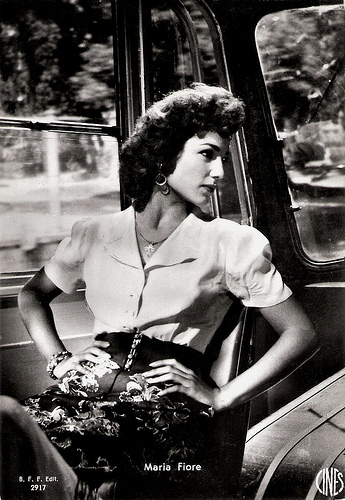
Italian postcard by B.F.F. Edit., Firenze, no 2917. Photo: Cines. Publicity still for Tempi nostri - Zibaldone n. 2/A Slice of Life (Alessandro Blasetti, Paul Paviot, 1954).
A determined young woman
Maria Fiore was born Jolanda Di Fiore in Rome in 1935.
She made an impressive film debut at the young age of 17 in the neo-realistic masterpiece Due soldi di speranza/Two Cents Worth of Hope (Renato Castellani, 1952), the third in director Castellani's young love trilogy. The story concerns the romance between the strong-willed and free-spirited Carmela (Fiore) and Antonio (Vincenzo Musolino). At the 1952 Cannes Film Festival, the film shared the Grand Prix with Orson Welles ’ Othello (1952).
Hal Erickson at AllMovie : “The ardor is one-sided at first, but Carmela is a determined young woman, willing to scale and conquer any obstacle in pursuing her heart's desire. Once he's ‘hooked,’ Antonio scurries from job to job to prove his financial viability. Faced with the hostility of their parents, Carmela and Antonio symbolically shed themselves of all responsibilities to others in a climactic act of stark-naked bravado.”
Fiore then co-starred with Sophia Loren in the drama-comedy La domenica della buona gente/Good Folk’s Sunday (Anton Giulio Majano, 1953) and played the title role opposite Henri Vidal in Scampolo 53 (Giorgio Bianchi, 1953), one of the many film versions of the Dario Niccodemi play.
The next year, she played an important supporting part in Carosello napoletano/Neapolitan Carousel (Ettore Giannini, 1954), the first major Italian musical of the post-war era. Léonide Massine starred as Antonio Petito, a notable Pulcinella performer, and an important figure of Neapolitan theatre in the 19th century. The film was entered into the 1954 Cannes Film Festival.
During the next decade, Fiore starred in a great number of romantic comedies and musicals, often set in Naples. Titles include Graziella (Giorgio Bianchi, 1955) with Jean-Pierre Mocky, I pappagalli/The Parrots (Bruno Paolinelli, 1955) starring Aldo Fabrizi and Alberto Sordi , Serenata a Maria/Serenade for Maria (Luigi Capuano, 1957), and Malafemmena (Armando Fizzarotti, 1957). These films were popular in Italy, but less known abroad.
Later, when the Peplum genre became popular, she also appeared credited as Joan Simons in epics like Ercole l'invincibile/Hercules the Invincible (Alvaro Mancori, 1964).
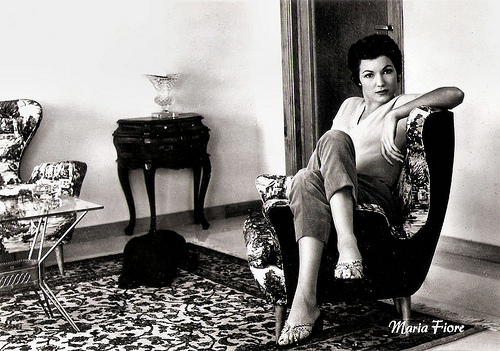
Italian postcard by Levibrom, Milano.
Rambo's Revenge
Maria Fiore disappeared from the big screen in the mid-1960s to concentrate on the dubbing firm she had set up.
She returned to popular success through hit TV mini-series such as Joe Petrosino (Daniele D'Anza, 1972) with Adolfo Celi, Accadde a Lisbona/It happened in Lisbon (Daniele D'Anza, 1974) with Paolo Stoppa , L'ultimo aereo per Venezia/The last plane to Venice (Daniele D'Anza, 1977) with Massimo Girotti , Quei 36 gradini/Those 36 steps (Luigi Perelli, 1984) with Gérard Blain , Little Roma (Francesco Massaro, 1988) and Pronto Soccorso/First Aid (Francesco Massaro, 1990-1992).
In the cinema she could be seen in the anthology film Se permettete parliamo di donne/Let's Talk About Women (Ettore Scola, 1964) with Vittorio Gassman , and the crime film L'onorata famiglia - Uccidere è cosa nostra/The Big Family (Tonino Ricci, 1973).
In 1975, Fiore played a supporting role in the Poliziotteschi film Il giustiziere sfida la città/Syndicate Sadists (Umberto Lenzi, 1975), starring Joseph Cotten and Tomas Milian . This film, also known as Rambo's Revenge and One Just Man, was one of director Lenzi's many efforts in the crime thriller genre. Tomas Milián plays Rambo, an ex-cop who seeks revenge against two powerful crime families who were responsible for the murder of his friend. The film predates Ted Kotcheff's First Blood (1982), the film which introduced audiences to the John Rambo of author David Morrell by seven years. Milian happened to read Morrell's novel while flying from the U.S. to Rome. Loving the story he tried to talk some Italian producers into making a film out of it, with him starring as John Rambo. Nothing came of this, but he was allowed to use the Rambo moniker in the next Poliziottesco he starred in.
Fiore’s last film was E insieme vivremo tutte le stagioni/And together we will live all seasons (Gianni Minello, 1999), starring Franco Citti.
In 2004, Maria Fiore died in Rome of lung cancer. She was 68.
Final scene of Due soldi di speranza/Two Cents Worth of Hope (1952). Source: Ugo Tramontano (YouTube).
Sources: Hal Erickson (AllMovie), (IMDb), Wikipedia (English and Italian), and .

Italian postcard by B.F.F. Edit., Firenze, no 2917. Photo: Cines. Publicity still for Tempi nostri - Zibaldone n. 2/A Slice of Life (Alessandro Blasetti, Paul Paviot, 1954).
A determined young woman
Maria Fiore was born Jolanda Di Fiore in Rome in 1935.
She made an impressive film debut at the young age of 17 in the neo-realistic masterpiece Due soldi di speranza/Two Cents Worth of Hope (Renato Castellani, 1952), the third in director Castellani's young love trilogy. The story concerns the romance between the strong-willed and free-spirited Carmela (Fiore) and Antonio (Vincenzo Musolino). At the 1952 Cannes Film Festival, the film shared the Grand Prix with Orson Welles ’ Othello (1952).
Hal Erickson at AllMovie : “The ardor is one-sided at first, but Carmela is a determined young woman, willing to scale and conquer any obstacle in pursuing her heart's desire. Once he's ‘hooked,’ Antonio scurries from job to job to prove his financial viability. Faced with the hostility of their parents, Carmela and Antonio symbolically shed themselves of all responsibilities to others in a climactic act of stark-naked bravado.”
Fiore then co-starred with Sophia Loren in the drama-comedy La domenica della buona gente/Good Folk’s Sunday (Anton Giulio Majano, 1953) and played the title role opposite Henri Vidal in Scampolo 53 (Giorgio Bianchi, 1953), one of the many film versions of the Dario Niccodemi play.
The next year, she played an important supporting part in Carosello napoletano/Neapolitan Carousel (Ettore Giannini, 1954), the first major Italian musical of the post-war era. Léonide Massine starred as Antonio Petito, a notable Pulcinella performer, and an important figure of Neapolitan theatre in the 19th century. The film was entered into the 1954 Cannes Film Festival.
During the next decade, Fiore starred in a great number of romantic comedies and musicals, often set in Naples. Titles include Graziella (Giorgio Bianchi, 1955) with Jean-Pierre Mocky, I pappagalli/The Parrots (Bruno Paolinelli, 1955) starring Aldo Fabrizi and Alberto Sordi , Serenata a Maria/Serenade for Maria (Luigi Capuano, 1957), and Malafemmena (Armando Fizzarotti, 1957). These films were popular in Italy, but less known abroad.
Later, when the Peplum genre became popular, she also appeared credited as Joan Simons in epics like Ercole l'invincibile/Hercules the Invincible (Alvaro Mancori, 1964).

Italian postcard by Levibrom, Milano.
Rambo's Revenge
Maria Fiore disappeared from the big screen in the mid-1960s to concentrate on the dubbing firm she had set up.
She returned to popular success through hit TV mini-series such as Joe Petrosino (Daniele D'Anza, 1972) with Adolfo Celi, Accadde a Lisbona/It happened in Lisbon (Daniele D'Anza, 1974) with Paolo Stoppa , L'ultimo aereo per Venezia/The last plane to Venice (Daniele D'Anza, 1977) with Massimo Girotti , Quei 36 gradini/Those 36 steps (Luigi Perelli, 1984) with Gérard Blain , Little Roma (Francesco Massaro, 1988) and Pronto Soccorso/First Aid (Francesco Massaro, 1990-1992).
In the cinema she could be seen in the anthology film Se permettete parliamo di donne/Let's Talk About Women (Ettore Scola, 1964) with Vittorio Gassman , and the crime film L'onorata famiglia - Uccidere è cosa nostra/The Big Family (Tonino Ricci, 1973).
In 1975, Fiore played a supporting role in the Poliziotteschi film Il giustiziere sfida la città/Syndicate Sadists (Umberto Lenzi, 1975), starring Joseph Cotten and Tomas Milian . This film, also known as Rambo's Revenge and One Just Man, was one of director Lenzi's many efforts in the crime thriller genre. Tomas Milián plays Rambo, an ex-cop who seeks revenge against two powerful crime families who were responsible for the murder of his friend. The film predates Ted Kotcheff's First Blood (1982), the film which introduced audiences to the John Rambo of author David Morrell by seven years. Milian happened to read Morrell's novel while flying from the U.S. to Rome. Loving the story he tried to talk some Italian producers into making a film out of it, with him starring as John Rambo. Nothing came of this, but he was allowed to use the Rambo moniker in the next Poliziottesco he starred in.
Fiore’s last film was E insieme vivremo tutte le stagioni/And together we will live all seasons (Gianni Minello, 1999), starring Franco Citti.
In 2004, Maria Fiore died in Rome of lung cancer. She was 68.
Final scene of Due soldi di speranza/Two Cents Worth of Hope (1952). Source: Ugo Tramontano (YouTube).
Sources: Hal Erickson (AllMovie), (IMDb), Wikipedia (English and Italian), and .
Published on June 28, 2015 22:00
June 27, 2015
Alida Valli
This week, we're in Bologna at
Il Cinema Ritrovato
. Our favourite venue is the giant screen in Piazza Maggiore where we will experience tonight "the extravagant cinematic inventions of The Third Man" - according to the Festival website. Just like her co-stars Joseph Cotten, Orson Welles and Trevor Howard, the female Italian star of this British classic is unforgettable... Strikingly beautiful Alida Valli (1921-2006) started as Italy’s sweetheart of the early 1940s. She fascinated audiences with her flawless porcelain face, her dark, voluptuous hair and her green, expressive eyes, but also with her ability to simultaneously hide and reveal a character's thoughts and emotions. In a career that spanned seven decades, she appeared in more than 110 films including such classics as Luchino Visconti's Senso (1954), Michelangelo Antonioni's Il Grido (1957) and Bernardo Bertolucci's Strategia del ragno (1970). And The Third Man (Carol Reed, 1949).
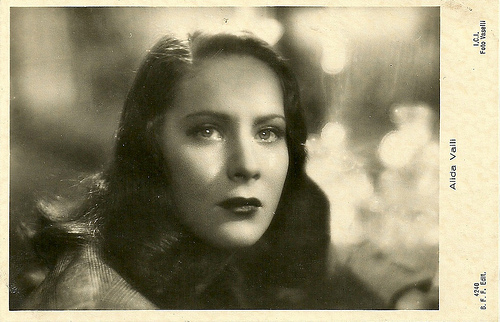
Italian postcard by Ballerini & Fratini, Firenze (B.F.F. Edit.), no. 4240. Photo: I.C.I. / Vaselli.
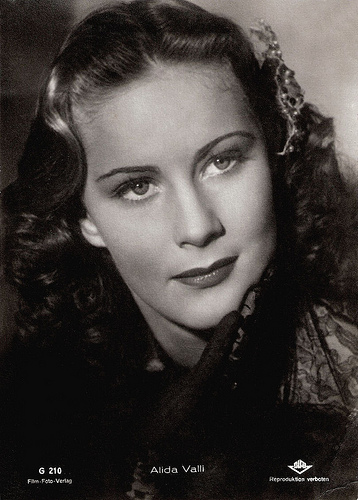
German postcard by Film-Foto-Verlag, no. G 210, 1941-1944. Photo: Difu.
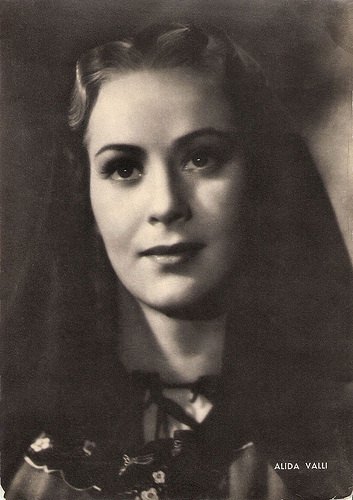
Italian postcard by Aser, Roma, no. 250. Photo: Pesce.
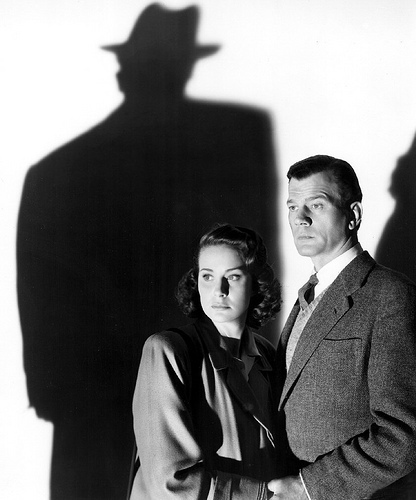
Still from The Third Man (1949) with Alida Valli and Joseph Cotten. Source: Dr. Macro's.
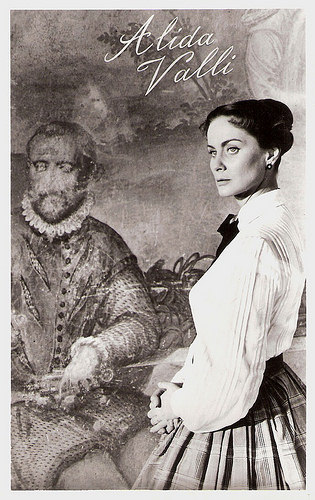
Dutch postcard by Takken, Utrecht, no. 1683. Photo: publicity still for Senso (Luchino Visconti, 1954).
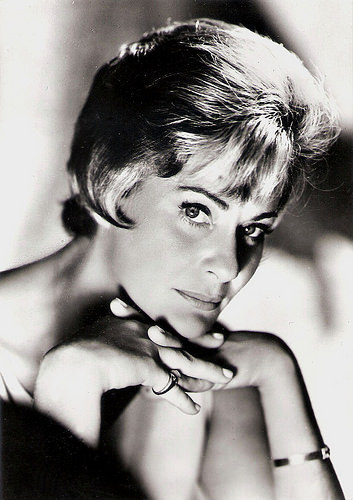
Italian postcard by Alterocca, Terni, no. 49474.
Cinécitta
Alida Valli was born as Alida Maria Laura von Altenburger in Pola, a town located in Italy’s Istria region (now Pula, the town currently is part of Croatia) in 1921. Her father, Baron Gino Altenburger, was a philosophy professor and part-time music critic of aristocratic Austrian descent (Alida’s title was Baroness of Marckenstein and Frauenberg) and her mother, Silvia Oberecker della Martina, was a piano teacher of mixed German-Italian parentage (some sources state that she was of Slovenian-Italian descent). Not long after Alida's birth, the family moved to Como, where Alida attended a local school.
Following her father’s death, she and her mother went to Rome where Alida studied acting at the Centro Sperimentale di Cinematografia (CSC), the film academy set up by Benito Mussolini. In 1936, at the age of 15, Alida Altenburger made her first film appearance in the Cinecittà studios with a bit part in I Due sergenti/The Two Sergeants (Enrico Guazzoni, 1936) starring Gino Cervi .
Her surname was changed to the more Italian-sounding Valli (supposedly found by chance in the phone book). In the following years, she often starred in the escapist Telefoni Bianchi productions – the ‘white telephone’ comedies and melodramas always set in very luxurious and wealthy environments.
In 1937, she appeared in the comedy L'amor mio non muore.../A Night in May (Raffaello Matarazzo, 1937), in which she played opposite the Neapolitan acting family Eduardo, Peppino, and Titina DeFilippo.
Her first big success came with the comedies Mille lire al mese/One Thousand Lire per Month (Max Neufeld, 1939) as a beauty with too many worshippers including Osvaldo Valenti, and Assenza ingiustificata/Absence Without Leave (Max Neufeld, 1939), as a young woman who decides to go back to school without the knowledge of her doctor husband ( Amedeo Nazzari ).
She proved her versatility with the costume drama Manon Lescaut (1940, Carmine Gallone), based on a novel by Abbé Prevost, in which she played the title role opposite matinee idol Vittorio De Sica . Valli’s popularity in the Italian film industry was now near its peak. A poll in the late 1930s had placed her behind only Assia Noris as the most popular female star in the country.
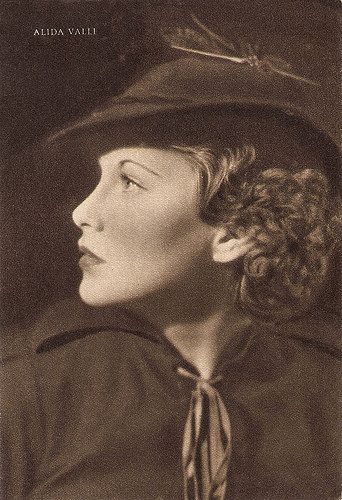
Italian postcard by Rizzoli, Milano, 1939.
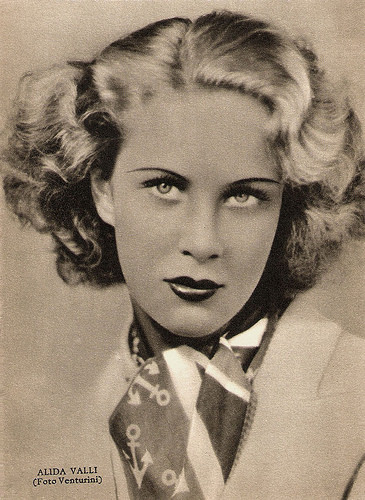
Italian postcard by Rizzoli, Milano, 1941. Photo: Venturini.
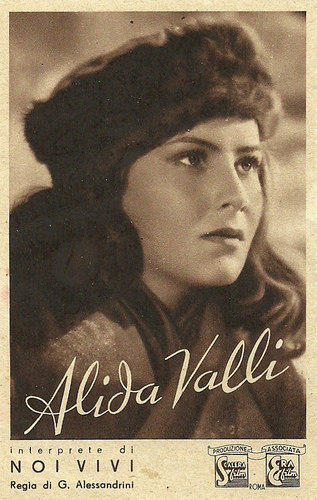
Italian postcard by Zincografica, Firenze. Photo: Scalera Film / Era Film, Roma. Publicity still for Noi Vivi/We the Living (Goffredo Alessandrini, 1942).
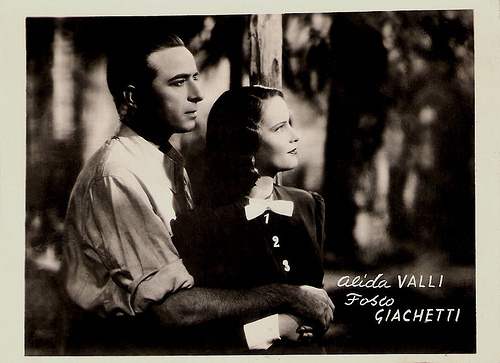
Italian postcard. With Fosco Giachetti .
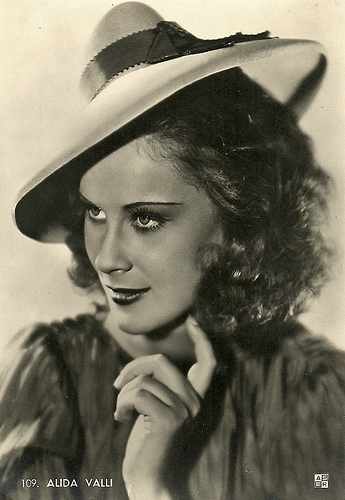
Italian postcard by ASER (A. Scaramaglia Ed. Roma), no. 109.
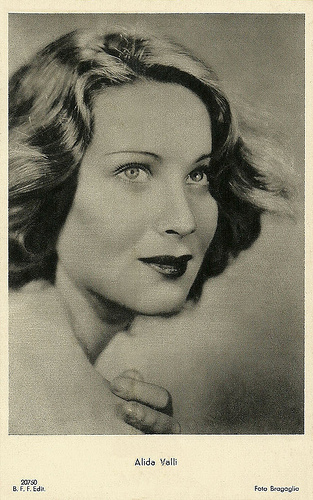
Italian postcard by B.F.F. Edit., no. 20750. Photo: Bragaglia.
Italy's Sweetheart
By the early 1940s, Alida Valli was top of the bill and became known as ‘Italy’s Sweetheart’. Italcine signed her to a five-year contract. She won an acting award at the Venice Film Festival for Piccolo mondo antico/Old-Fashioned World (Mario Soldati, 1941) with Massimo Serato , about a woman traumatized by her child's death.
During the Second World War, another major success followed with Stasera niente di nuovo/Nothing New This Evening (Mario Mattoli, 1942), the story of a prostitute who refuses help from the reporter (Carlo Ninchi) who loves her. In the film Valli gets to sing Giovanno D’Anzi’s massive hit Ma l’amore no.
For the 19-year-old star, fame and adulation brought both riches and difficulties. Next she played a counter-revolutionary opposite Fosco Giachetti and Rossano Brazzi in Noi Vivi - Addio Kira/We the Living (Goffredo Alessandrini, 1942), based on Ayn Rand's anti-Communist novel. The films were successful, and the public easily realized that they were as much against Fascism as Communism. After several weeks, however, the films were pulled from theatres as the German and Italian governments, which abhorred communism, found out the story also carried an anti-fascist message.
With the Nazi push into Italy, she briefly left film making and hid in a friend's apartment to avoid recruitment into propaganda efforts. Others who joined her there were the jazz composer and surrealist painter Oscar De Mejo, who became her husband in 1944, and jazz pianist Piero Piccioni, who would much later become her lover.
After the war it was the title role in Eugenia Grandet/Eugenie Grandet (Mario Soldati, 1947), an adaptation of Honoré de Balzac’s novel, that marked her return to form. As the suffering Eugenia, she won a best actress Nastro d’Argento award from the Union of Italian Film Journalists, and caught the eye of independent Hollywood producer David O. Selznick.
Selznick signed her to a contract, and groomed her for a major English-language career. She was given a screen billing with just her surname - Valli - to recall the European glamour of ‘Garbo’. However, she was plunked in mediocre fare and, with a language barrier, had a catatonic presence that did not showcase the emotion she brought to her earlier Italian period. American audiences yawned at Alfred Hitchcock's The Paradine Case (1947), in which she was murder suspect Maddalena Paradine defended by Gregory Peck, and The Miracle of the Bells (Irving Pichel, 1948) with Frank Sinatra, in which she played a dead actress whose story is told in flashback.
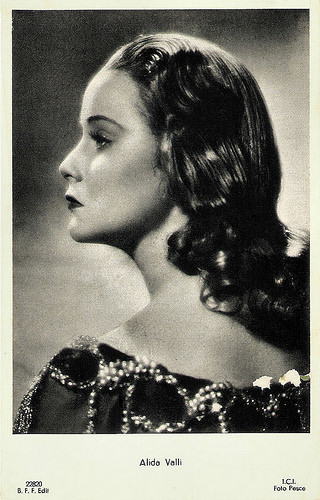
Italian postcard by B.F.F. Edit., no. 22820. Photo: I.C.I. / Pesce.
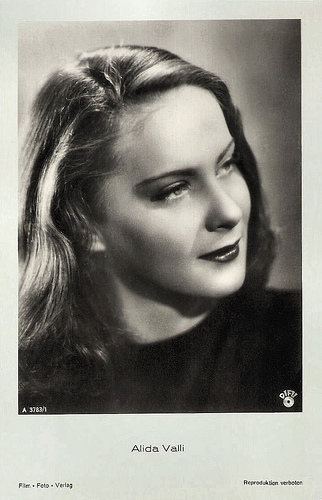
German postcard by Film-Foto-Verlag, no. A 3783/1, 1941-1944. Photo: DIFU.
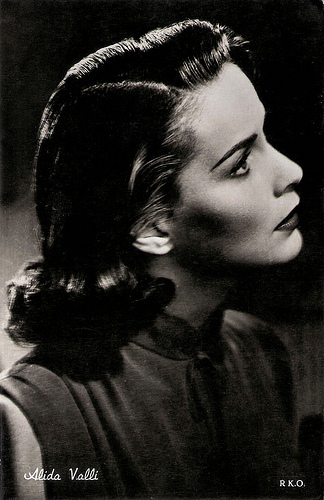
Italian postcard. Photo: RKO.
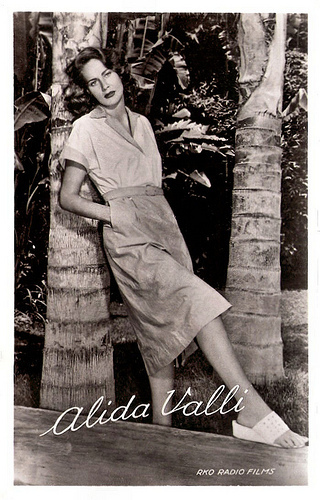
Dutch postcard. Photo: RKO Radio Films.
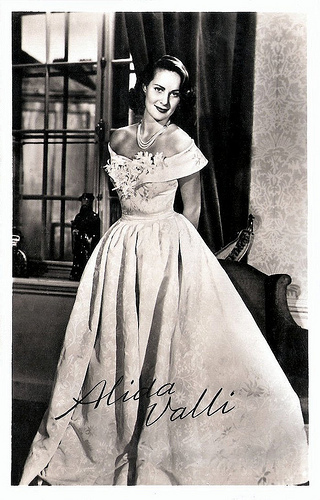
Dutch postcard.
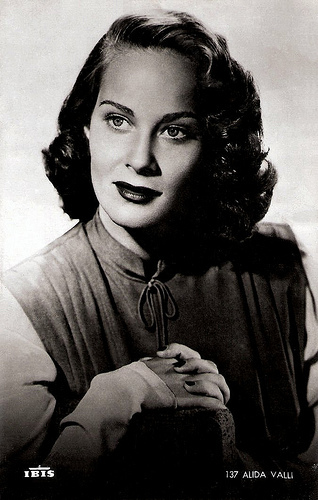
Vintage postcard by IBIS, no. 137.
A Classic Of Unremitting Political Cynicism
With Selznick's approval, Alida Valli left for England where she was cast as a mysterious Czech refugee Anna Schmidt wanted by the Russians in post-war Vienna in The Third Man (Carol Reed, 1949). Anna is the devoted lover of Harry Lime ( Orson Welles ), a racketeer in the black-market world.
The Third Man has since become a classic of unremitting political cynicism, aided by an unexpected zither soundtrack and unforgettable, powerful scenes. One of the best is the final shot in a cemetery, which shows her walking directly past the bumbling American hero (Joseph Cotten), a pulp novelist who, despite all evidence to the contrary, wants to view her character as a damsel in distress.
Valli returned permanently to Europe in 1951 to star opposite Jean Marais in Les Miracles n’ont lieu qu’une fois/Miracles Only Happen Once (Yves Allégret, 1951). It is the story of two enamoured students who, after being separated by the war, are reunited ten years later only to discover that they have changed.
Luchino Visconti offered her the lead role in Senso/Livia (Luchino Visconti, 1954), a beautiful period piece of romance and betrayal based on a novel by Camillo Boito. Set in mid-1800s Venice during the Risorgimento, the film revolves around a Venetian countess torn between nationalistic feelings and an adulterous love for an officer ( Farley Granger ) of the occupying Austrian forces. Her passionate performance is considered by some the apex of her career, and won her a Best Actress Crystal Star from the French Film Academy. (Senso’s loss at the 1954 Venice Film Festival - the Golden Lion for Best Film went to Renato Castellani’s Romeo and Juliet - caused a furore).
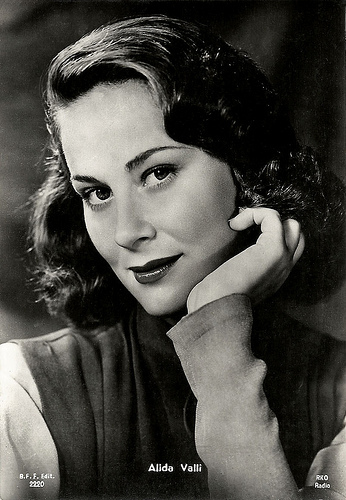
Italian postcard. Ballerini & Fratini, Firenze (B.F.F. Edit.), no 2220. Photo: RKO Radio.
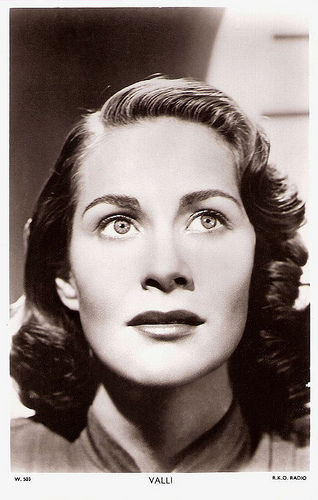
British postcard in the Picturegoer Series, London, no. W 503. Photo: R.K.O. Radio.
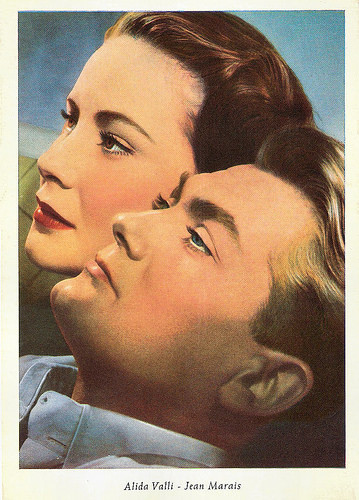
German postcard by Wilhelm Schulze-Witteburg Graphischer Betrieb (WS-Druck), Wanne Eickel. Photo: Deutsche Commerz Film GmbH. Publicity still of Jean Marais and Alida Valli in Les Miracles n'ont lieu qu'une fois/Miracles Only Happen Once (Yves Allégret, 1951).
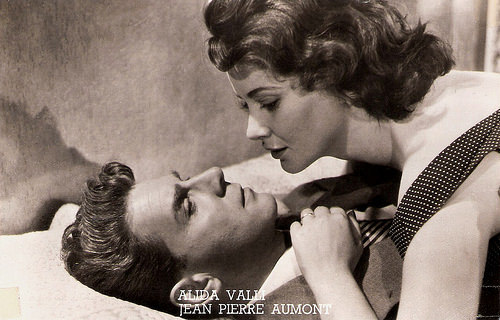
Vintage Postcard, no. 952. Publicity still for Ultimo incontro/Last Meeting (Gianni Franciolini, 1951) with Jean-Pierre Aumont .
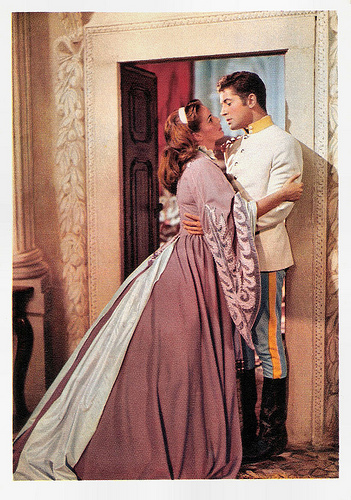
Italian postcard by Rotocalco Dagnino, Torino. Photo: Lux Film. Alida Valli and Farley Granger as countess Livia Serpieri and Lt. Franz Mahler in Luchino Visconti's historical film Senso (1954).
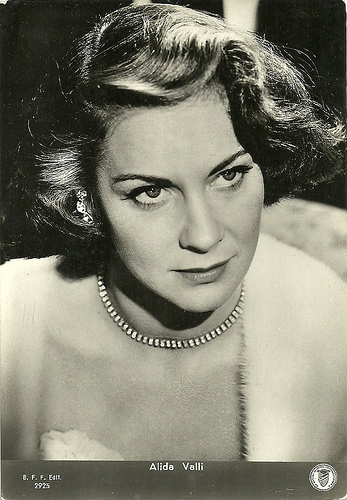
Italian postcard by Ballerini & Fratini, Firenze (B.F.F. Edit.), no. 2925. Photo: Titanus.
Sex and Drugs Scandal
As her career was beginning to pick up steam again, Alida Valli became involved in a sex and drugs scandal following the mysterious death of a 20-year-old fashion model named Wilma Montesi, whose body was found on a beach near Rome. Prolonged investigations resulted, involving sensational allegations of drugs and sex orgies in Roman society. Among the accused – all of whom were acquitted, leaving the case unsolved – was Valli's lover, jazz musician Piero Piccioni (son of the Italian Minister of Foreign Affairs). Alida Valli was divorced from Oscar De Mejo in 1952, and she claimed that she and Piccioni were staying at a villa in Capri at the time of the death of Montesi. This was a factor in his acquittal at the trial.
The scandal inspired Federico Fellini's La Dolce Vita/The Sweet Life (1960). In 1957 Valli once again made a glorious come-back with her role in another classic of the European cinema, Michelangelo Antonioni's Il Grido/The Cry (1957) with Steve Cochran. She played a weary and impoverished woman who rejects her working-class lover.
In Italy, she was also well-known for her stage appearances. She had easily moved from ingénue to vivid character roles. In 1956, she made her stage début, starring under the direction of her future husband Giancarlo Zagni at Palermo’s Teatro Biondo in Henrik Ibsen’s Rosmersholm, William Archibald’s The Innocents, and Luigi Pirandello’s L’uomo, la bestia e la virtù/The Man, the Beast and Virtue. She was to appear in more than thirty plays in the next four decades.
Among her later films were La Grande strada azzurra/The Wide Blue Road (Gillo Pontecorvo, 1957) starring Yves Montand , the horror masterpiece Les Yeux sans visage/Eyes Without a Face (Georges Franju, 1960), Une Aussi longue absence/The Long Absence (Henri Colpi, 1962), Ophelia (Claude Chabrol, 1963) with Juliette Mayniel , El hombre de papel/The Paper Man (Ismael Rodriguez, 1963), Edipo re/Oedipus Rex (Pier Paolo Pasolini, 1967) with Silvana Mangano , La prima notte di quiete/The Professor (Valerio Zurlini, 1972), starring Alain Delon , and La Chair de l'orchidée/Flesh of the Orchid (Patrice Chéreau, 1975), starring Charlotte Rampling .
She worked three times with Bernardo Bertolucci, in La strategia del ragno/The Spider's Stratagem (1970), Novecento/1900 (1976), and La Luna/Luna (1979). She also worked with such horror masters as Mario Bava in La Casa dell'esorcismo/The House of Exorcism (1973) and Dario Argento in Suspiria (1977) and Inferno (1980).
More recent were her roles in Il Lungo silenzio/The Long Silence (1993, Margaretha von Trotta) and A Month by the Lake (John Irvin, 1995). Her final film role was in Semana Santa/Angel of Death (Pepe Danquart, 2002), with Mira Sorvino.
In 2006, Alida Valli died in Rome at the age of 84. She had two sons with Oscar De Mejo, Carlo De Mejo and Lorenzo 'Larry' De Mejo. Her grandson Pierpaolo De Mejo is an actor and director, who made the documentary Come diventai Alida Valli/How I Became Alida Valli (2008) about his grandmother.
Trailer for The Third Man (1949). Source: Britmovies (YouTube).
Trailer for Senso (1954). Source: The Criterion Collection (YouTube).
Trailer for Il Grido/The Cry (1957). Source: Danios 12345 (YouTube).
Trailer for La strategia del ragno/The Spider's Stratagem (1970). Source: Dive Italiane (YouTube). Sorry, no subtitles.
Trailer for Suspiria (1977). Source: Oliver Gašpar (YouTube).
Sources: Michael Plass (Alida Valli Net) (German), Adam Bernstein (Washington Post), Andre Soares (Alternative Film Guide), (IMDb), Wikipedia, Reel Classics, and .

Italian postcard by Ballerini & Fratini, Firenze (B.F.F. Edit.), no. 4240. Photo: I.C.I. / Vaselli.

German postcard by Film-Foto-Verlag, no. G 210, 1941-1944. Photo: Difu.

Italian postcard by Aser, Roma, no. 250. Photo: Pesce.

Still from The Third Man (1949) with Alida Valli and Joseph Cotten. Source: Dr. Macro's.

Dutch postcard by Takken, Utrecht, no. 1683. Photo: publicity still for Senso (Luchino Visconti, 1954).

Italian postcard by Alterocca, Terni, no. 49474.
Cinécitta
Alida Valli was born as Alida Maria Laura von Altenburger in Pola, a town located in Italy’s Istria region (now Pula, the town currently is part of Croatia) in 1921. Her father, Baron Gino Altenburger, was a philosophy professor and part-time music critic of aristocratic Austrian descent (Alida’s title was Baroness of Marckenstein and Frauenberg) and her mother, Silvia Oberecker della Martina, was a piano teacher of mixed German-Italian parentage (some sources state that she was of Slovenian-Italian descent). Not long after Alida's birth, the family moved to Como, where Alida attended a local school.
Following her father’s death, she and her mother went to Rome where Alida studied acting at the Centro Sperimentale di Cinematografia (CSC), the film academy set up by Benito Mussolini. In 1936, at the age of 15, Alida Altenburger made her first film appearance in the Cinecittà studios with a bit part in I Due sergenti/The Two Sergeants (Enrico Guazzoni, 1936) starring Gino Cervi .
Her surname was changed to the more Italian-sounding Valli (supposedly found by chance in the phone book). In the following years, she often starred in the escapist Telefoni Bianchi productions – the ‘white telephone’ comedies and melodramas always set in very luxurious and wealthy environments.
In 1937, she appeared in the comedy L'amor mio non muore.../A Night in May (Raffaello Matarazzo, 1937), in which she played opposite the Neapolitan acting family Eduardo, Peppino, and Titina DeFilippo.
Her first big success came with the comedies Mille lire al mese/One Thousand Lire per Month (Max Neufeld, 1939) as a beauty with too many worshippers including Osvaldo Valenti, and Assenza ingiustificata/Absence Without Leave (Max Neufeld, 1939), as a young woman who decides to go back to school without the knowledge of her doctor husband ( Amedeo Nazzari ).
She proved her versatility with the costume drama Manon Lescaut (1940, Carmine Gallone), based on a novel by Abbé Prevost, in which she played the title role opposite matinee idol Vittorio De Sica . Valli’s popularity in the Italian film industry was now near its peak. A poll in the late 1930s had placed her behind only Assia Noris as the most popular female star in the country.

Italian postcard by Rizzoli, Milano, 1939.

Italian postcard by Rizzoli, Milano, 1941. Photo: Venturini.

Italian postcard by Zincografica, Firenze. Photo: Scalera Film / Era Film, Roma. Publicity still for Noi Vivi/We the Living (Goffredo Alessandrini, 1942).

Italian postcard. With Fosco Giachetti .

Italian postcard by ASER (A. Scaramaglia Ed. Roma), no. 109.

Italian postcard by B.F.F. Edit., no. 20750. Photo: Bragaglia.
Italy's Sweetheart
By the early 1940s, Alida Valli was top of the bill and became known as ‘Italy’s Sweetheart’. Italcine signed her to a five-year contract. She won an acting award at the Venice Film Festival for Piccolo mondo antico/Old-Fashioned World (Mario Soldati, 1941) with Massimo Serato , about a woman traumatized by her child's death.
During the Second World War, another major success followed with Stasera niente di nuovo/Nothing New This Evening (Mario Mattoli, 1942), the story of a prostitute who refuses help from the reporter (Carlo Ninchi) who loves her. In the film Valli gets to sing Giovanno D’Anzi’s massive hit Ma l’amore no.
For the 19-year-old star, fame and adulation brought both riches and difficulties. Next she played a counter-revolutionary opposite Fosco Giachetti and Rossano Brazzi in Noi Vivi - Addio Kira/We the Living (Goffredo Alessandrini, 1942), based on Ayn Rand's anti-Communist novel. The films were successful, and the public easily realized that they were as much against Fascism as Communism. After several weeks, however, the films were pulled from theatres as the German and Italian governments, which abhorred communism, found out the story also carried an anti-fascist message.
With the Nazi push into Italy, she briefly left film making and hid in a friend's apartment to avoid recruitment into propaganda efforts. Others who joined her there were the jazz composer and surrealist painter Oscar De Mejo, who became her husband in 1944, and jazz pianist Piero Piccioni, who would much later become her lover.
After the war it was the title role in Eugenia Grandet/Eugenie Grandet (Mario Soldati, 1947), an adaptation of Honoré de Balzac’s novel, that marked her return to form. As the suffering Eugenia, she won a best actress Nastro d’Argento award from the Union of Italian Film Journalists, and caught the eye of independent Hollywood producer David O. Selznick.
Selznick signed her to a contract, and groomed her for a major English-language career. She was given a screen billing with just her surname - Valli - to recall the European glamour of ‘Garbo’. However, she was plunked in mediocre fare and, with a language barrier, had a catatonic presence that did not showcase the emotion she brought to her earlier Italian period. American audiences yawned at Alfred Hitchcock's The Paradine Case (1947), in which she was murder suspect Maddalena Paradine defended by Gregory Peck, and The Miracle of the Bells (Irving Pichel, 1948) with Frank Sinatra, in which she played a dead actress whose story is told in flashback.

Italian postcard by B.F.F. Edit., no. 22820. Photo: I.C.I. / Pesce.

German postcard by Film-Foto-Verlag, no. A 3783/1, 1941-1944. Photo: DIFU.

Italian postcard. Photo: RKO.

Dutch postcard. Photo: RKO Radio Films.

Dutch postcard.

Vintage postcard by IBIS, no. 137.
A Classic Of Unremitting Political Cynicism
With Selznick's approval, Alida Valli left for England where she was cast as a mysterious Czech refugee Anna Schmidt wanted by the Russians in post-war Vienna in The Third Man (Carol Reed, 1949). Anna is the devoted lover of Harry Lime ( Orson Welles ), a racketeer in the black-market world.
The Third Man has since become a classic of unremitting political cynicism, aided by an unexpected zither soundtrack and unforgettable, powerful scenes. One of the best is the final shot in a cemetery, which shows her walking directly past the bumbling American hero (Joseph Cotten), a pulp novelist who, despite all evidence to the contrary, wants to view her character as a damsel in distress.
Valli returned permanently to Europe in 1951 to star opposite Jean Marais in Les Miracles n’ont lieu qu’une fois/Miracles Only Happen Once (Yves Allégret, 1951). It is the story of two enamoured students who, after being separated by the war, are reunited ten years later only to discover that they have changed.
Luchino Visconti offered her the lead role in Senso/Livia (Luchino Visconti, 1954), a beautiful period piece of romance and betrayal based on a novel by Camillo Boito. Set in mid-1800s Venice during the Risorgimento, the film revolves around a Venetian countess torn between nationalistic feelings and an adulterous love for an officer ( Farley Granger ) of the occupying Austrian forces. Her passionate performance is considered by some the apex of her career, and won her a Best Actress Crystal Star from the French Film Academy. (Senso’s loss at the 1954 Venice Film Festival - the Golden Lion for Best Film went to Renato Castellani’s Romeo and Juliet - caused a furore).

Italian postcard. Ballerini & Fratini, Firenze (B.F.F. Edit.), no 2220. Photo: RKO Radio.

British postcard in the Picturegoer Series, London, no. W 503. Photo: R.K.O. Radio.

German postcard by Wilhelm Schulze-Witteburg Graphischer Betrieb (WS-Druck), Wanne Eickel. Photo: Deutsche Commerz Film GmbH. Publicity still of Jean Marais and Alida Valli in Les Miracles n'ont lieu qu'une fois/Miracles Only Happen Once (Yves Allégret, 1951).

Vintage Postcard, no. 952. Publicity still for Ultimo incontro/Last Meeting (Gianni Franciolini, 1951) with Jean-Pierre Aumont .

Italian postcard by Rotocalco Dagnino, Torino. Photo: Lux Film. Alida Valli and Farley Granger as countess Livia Serpieri and Lt. Franz Mahler in Luchino Visconti's historical film Senso (1954).

Italian postcard by Ballerini & Fratini, Firenze (B.F.F. Edit.), no. 2925. Photo: Titanus.
Sex and Drugs Scandal
As her career was beginning to pick up steam again, Alida Valli became involved in a sex and drugs scandal following the mysterious death of a 20-year-old fashion model named Wilma Montesi, whose body was found on a beach near Rome. Prolonged investigations resulted, involving sensational allegations of drugs and sex orgies in Roman society. Among the accused – all of whom were acquitted, leaving the case unsolved – was Valli's lover, jazz musician Piero Piccioni (son of the Italian Minister of Foreign Affairs). Alida Valli was divorced from Oscar De Mejo in 1952, and she claimed that she and Piccioni were staying at a villa in Capri at the time of the death of Montesi. This was a factor in his acquittal at the trial.
The scandal inspired Federico Fellini's La Dolce Vita/The Sweet Life (1960). In 1957 Valli once again made a glorious come-back with her role in another classic of the European cinema, Michelangelo Antonioni's Il Grido/The Cry (1957) with Steve Cochran. She played a weary and impoverished woman who rejects her working-class lover.
In Italy, she was also well-known for her stage appearances. She had easily moved from ingénue to vivid character roles. In 1956, she made her stage début, starring under the direction of her future husband Giancarlo Zagni at Palermo’s Teatro Biondo in Henrik Ibsen’s Rosmersholm, William Archibald’s The Innocents, and Luigi Pirandello’s L’uomo, la bestia e la virtù/The Man, the Beast and Virtue. She was to appear in more than thirty plays in the next four decades.
Among her later films were La Grande strada azzurra/The Wide Blue Road (Gillo Pontecorvo, 1957) starring Yves Montand , the horror masterpiece Les Yeux sans visage/Eyes Without a Face (Georges Franju, 1960), Une Aussi longue absence/The Long Absence (Henri Colpi, 1962), Ophelia (Claude Chabrol, 1963) with Juliette Mayniel , El hombre de papel/The Paper Man (Ismael Rodriguez, 1963), Edipo re/Oedipus Rex (Pier Paolo Pasolini, 1967) with Silvana Mangano , La prima notte di quiete/The Professor (Valerio Zurlini, 1972), starring Alain Delon , and La Chair de l'orchidée/Flesh of the Orchid (Patrice Chéreau, 1975), starring Charlotte Rampling .
She worked three times with Bernardo Bertolucci, in La strategia del ragno/The Spider's Stratagem (1970), Novecento/1900 (1976), and La Luna/Luna (1979). She also worked with such horror masters as Mario Bava in La Casa dell'esorcismo/The House of Exorcism (1973) and Dario Argento in Suspiria (1977) and Inferno (1980).
More recent were her roles in Il Lungo silenzio/The Long Silence (1993, Margaretha von Trotta) and A Month by the Lake (John Irvin, 1995). Her final film role was in Semana Santa/Angel of Death (Pepe Danquart, 2002), with Mira Sorvino.
In 2006, Alida Valli died in Rome at the age of 84. She had two sons with Oscar De Mejo, Carlo De Mejo and Lorenzo 'Larry' De Mejo. Her grandson Pierpaolo De Mejo is an actor and director, who made the documentary Come diventai Alida Valli/How I Became Alida Valli (2008) about his grandmother.
Trailer for The Third Man (1949). Source: Britmovies (YouTube).
Trailer for Senso (1954). Source: The Criterion Collection (YouTube).
Trailer for Il Grido/The Cry (1957). Source: Danios 12345 (YouTube).
Trailer for La strategia del ragno/The Spider's Stratagem (1970). Source: Dive Italiane (YouTube). Sorry, no subtitles.
Trailer for Suspiria (1977). Source: Oliver Gašpar (YouTube).
Sources: Michael Plass (Alida Valli Net) (German), Adam Bernstein (Washington Post), Andre Soares (Alternative Film Guide), (IMDb), Wikipedia, Reel Classics, and .
Published on June 27, 2015 22:00
June 26, 2015
The Thief of Bagdad (1940)
Yes, this week, we're back in Italy for the 29th Il Cinema Ritrovato in Bologna! One of this edition's sections is Technicolor & Co. It is a rediscovery of the original colour of film with a special celebration of Technicolor, which in 2015 turns 100! The section includes the last film made in Technicolor, The Thin Red Line (1998) by Terrence Malick, and the digital restoration of Victor Fleming’s The Wizard of Oz (1939) in 3D, an ‘impossible’ restoration of a film that was not originally conceived in three dimensions. And today, there is that wonderful classic The Thief of Bagdad (1941) by Ludwig Berger, Michael Powell and Tim Whelan. Alas, not all our postcards are in Technicolor.
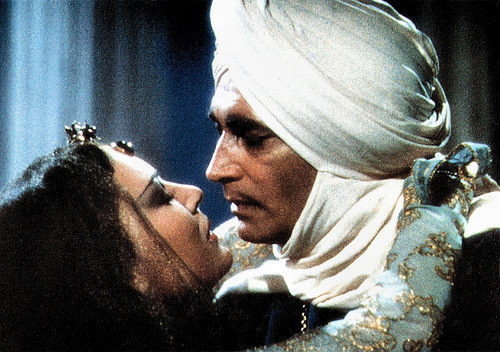
Italian programme card for Il Cinema Ritrovata 2011. Photo: publicity still for The Thief of Bagdad (Ludwig Berger, Michael Powell, Tim Whelan, Alexander Korda, Zoltan Korda, William Cameron Menzies, 1940) with June Deprez as the Princess and Conrad Veidt as Jaffar. Vivien Leigh was originally cast in the role of the Princess, but when, in late 1938, she won the part of Scarlett O'Hara in Gone with the Wind (1939). Producer Alexander Korda gave the role to Duprez.
The best Arabian Nights adventure ever
There have been several film versions of the story of the good-natured young thief of ancient Bagdad (as it was once spelled). Raoul Walsh made the first, silent, rendering of Thief of Bagdad in 1924, starring Douglas Fairbanks. Still a marvellously entertaining film.
But the best Arabian Nights adventure ever is the 1940's Technicolor version of The Thief of Bagdad. It has a startling, magical panoply of top quality special effects, which still work their charm after more than seventy years, a stellar cast and wonderfully catchy music. The Thief of Bagdad is simply one of the best fantasy films ever made. But who was the director?
Bruce Eder at AllMovie : "Essentially behind (the original director Ludwig) Berger's back, British director Michael Powell was brought in to shoot various scenes - and Powell's scheduled work grew in amount and importance whilst, in the meantime, Korda himself did his best to undercut Berger on his own set; and while publicly siding with Berger on the issue of the music, he also undercut Berger's chosen composer (Oscar Straus) by bringing in Miklos Rozsa and putting him into an office directly adjacent to Berger's with a piano, to work on a score. Eventually, Berger was persuaded to walk away from the project, and American filmmaker Tim Whalen, who had just finished work on another Korda-produced movie (Q Planes) was brought in to help augment Powell's work."
Producer Alexander Korda was so demanding that he went through six directors during the production of The Thief of Bagdad, including his brother Zoltan Korda and leading art director William Cameron Menzies. For the special effects, from a magic flying carpet to the gargantuan genie who pops out of a bottle with a tornado-like black swirl, two men were responsible: Lawrence W. Butler and Tom Howard. Both had long and distinguished careers in technical wizardry.
Bruce Eder: "Accounts by those involved have varied across the decades, but most maintained that hardly anything directed by Berger made the final cut; the film is considered a prime example of Powell's early output, displaying the wit, flair, and stylish camerawork that would inform his subsequent work."
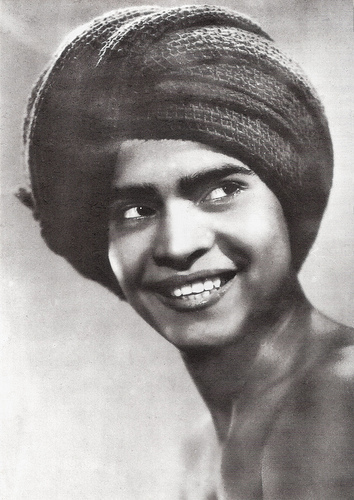
German collectors card by Küno's Film-Foto in the series Der Dieb von Bagdad, no. 1, presented by Sparkasse bank. Photo: publicity still for The Thief of Bagdad (Ludwig Berger, Michael Powell, Tim Whelan, 1940) with Sabu as Abu.
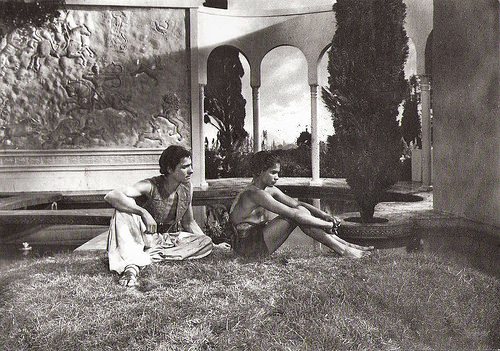
German collectors card by Küno's Film-Foto in the series Der Dieb von Bagdad, no. 2, presented by Sparkasse bank. Photo: publicity still for The Thief of Bagdad (Ludwig Berger, Michael Powell, Tim Whelan, 1940) with John Justin as Ahmad and Sabu as Abu.
A genie with an attitude
The Thief of Bagdad stars Sabu as the boy thief, Abu, the debuting John Justin as the dreamily in love prince Ahmad and young up-and-coming starlet June Duprez as the lovely princess sought by Ahmad and pursued by the evil vizier, Jaffar, played by a sinister Conrad Veidt . Rex Ingram plays the giant genie in the bottle who has an equally massive attitude.
The story focusses on Prince Ahmad, the rightful King of Bagdad. The idealistic prince wants to slum it amongst his people for a while to check things out. But the evil Vizier Jaffar takes his chance to imprison the beggar-prince and seize the throne.
Ahmad is cast into the palace dungeon where he meets Abu, the best thief in all Bagdad. Together they escape and make their way to Basra where Ahmad falls in love with the beautiful Princess.
However, Jaffar also journeys to Basra, for he desires the Princess. Her father, the Sultan (Miles Malleson, who also wrote the screenplay), is fascinated by the magical mechanical flying horse Jaffar offers and agrees to the proposed marriage. Upon hearing the news, the Princess, by now deeply in love with Ahmad, runs away.
The prince and thief are haunted by Jaffar. He magically blinds Ahmad and turns Abu into a dog. The spell can only be broken if Jaffar holds the Princess in his arms.
It's just the start of Ahmad and Abu's dazzling adventures that involve an all-seeing magic jewel, a giant spider, a flying carpet and that massive Djinn in a bottle.
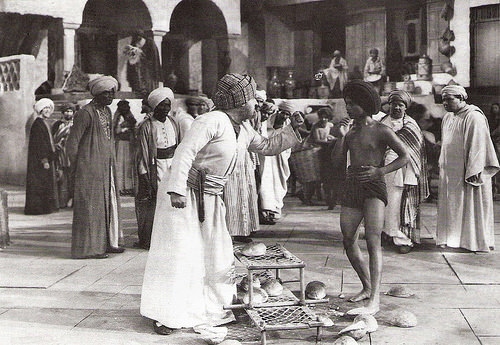
German collectors card by Küno's Film-Foto in the series Der Dieb von Bagdad, no. 3 presented by Sparkasse bank. Photo: publicity still for The Thief of Bagdad (Ludwig Berger, Michael Powell, Tim Whelan, 1940) with Sabu .
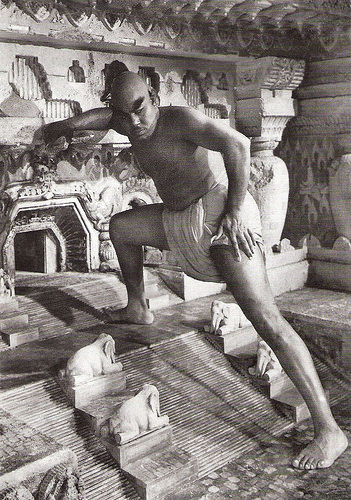
German collectors card by Küno's Film-Foto in the series Der Dieb von Bagdad, no. 4, presented by Sparkasse bank. Photo: publicity still for The Thief of Bagdad (Ludwig Berger, Michael Powell, Tim Whelan, 1940) with Rex Ingram as the Djinn.
The tops of the actresses' costumes had to be buttoned up
Filming of The Thief of Bagdad began at London's Denham Studios, which had just merged with J. Arthur Rank's nearby Pinewood Studios.
Because of the Blitz, the production had to be relocated to Hollywood. There was such a long break in production, Sabu 's early scenes had to be re-shot because he had grown several inches.
When filming began in the US, the stricter censorship codes of the Hays Office there were applied. One of the most obvious differences between the scenes shot in the UK and those filmed in the USA is that the tops of the actresses' costumes were buttoned up all the way to satisfy the Hays Office. That kind of clue makes it easier to identify the US-shot scenes than trying to spot differences in the sets.
The film won three Oscars: Production design by William Cameron Menzies and Vincent Korda, Cinematography by George Perinal and Special effects by Osmond Borradaile . Furthermore one nomination for the evocative and oriental musical score by Miklos Rozsa.
Trailer for The Thief of Bagdad (Ludwig Berger, Michael Powell, Tim Whelan, 1940). Source: Plamen Plamenov (YouTube).
Sources: Bruce Eder (AllMovie), Il Cinema Ritrovato 2015, Wikipedia and IMDb.

Italian programme card for Il Cinema Ritrovata 2011. Photo: publicity still for The Thief of Bagdad (Ludwig Berger, Michael Powell, Tim Whelan, Alexander Korda, Zoltan Korda, William Cameron Menzies, 1940) with June Deprez as the Princess and Conrad Veidt as Jaffar. Vivien Leigh was originally cast in the role of the Princess, but when, in late 1938, she won the part of Scarlett O'Hara in Gone with the Wind (1939). Producer Alexander Korda gave the role to Duprez.
The best Arabian Nights adventure ever
There have been several film versions of the story of the good-natured young thief of ancient Bagdad (as it was once spelled). Raoul Walsh made the first, silent, rendering of Thief of Bagdad in 1924, starring Douglas Fairbanks. Still a marvellously entertaining film.
But the best Arabian Nights adventure ever is the 1940's Technicolor version of The Thief of Bagdad. It has a startling, magical panoply of top quality special effects, which still work their charm after more than seventy years, a stellar cast and wonderfully catchy music. The Thief of Bagdad is simply one of the best fantasy films ever made. But who was the director?
Bruce Eder at AllMovie : "Essentially behind (the original director Ludwig) Berger's back, British director Michael Powell was brought in to shoot various scenes - and Powell's scheduled work grew in amount and importance whilst, in the meantime, Korda himself did his best to undercut Berger on his own set; and while publicly siding with Berger on the issue of the music, he also undercut Berger's chosen composer (Oscar Straus) by bringing in Miklos Rozsa and putting him into an office directly adjacent to Berger's with a piano, to work on a score. Eventually, Berger was persuaded to walk away from the project, and American filmmaker Tim Whalen, who had just finished work on another Korda-produced movie (Q Planes) was brought in to help augment Powell's work."
Producer Alexander Korda was so demanding that he went through six directors during the production of The Thief of Bagdad, including his brother Zoltan Korda and leading art director William Cameron Menzies. For the special effects, from a magic flying carpet to the gargantuan genie who pops out of a bottle with a tornado-like black swirl, two men were responsible: Lawrence W. Butler and Tom Howard. Both had long and distinguished careers in technical wizardry.
Bruce Eder: "Accounts by those involved have varied across the decades, but most maintained that hardly anything directed by Berger made the final cut; the film is considered a prime example of Powell's early output, displaying the wit, flair, and stylish camerawork that would inform his subsequent work."

German collectors card by Küno's Film-Foto in the series Der Dieb von Bagdad, no. 1, presented by Sparkasse bank. Photo: publicity still for The Thief of Bagdad (Ludwig Berger, Michael Powell, Tim Whelan, 1940) with Sabu as Abu.

German collectors card by Küno's Film-Foto in the series Der Dieb von Bagdad, no. 2, presented by Sparkasse bank. Photo: publicity still for The Thief of Bagdad (Ludwig Berger, Michael Powell, Tim Whelan, 1940) with John Justin as Ahmad and Sabu as Abu.
A genie with an attitude
The Thief of Bagdad stars Sabu as the boy thief, Abu, the debuting John Justin as the dreamily in love prince Ahmad and young up-and-coming starlet June Duprez as the lovely princess sought by Ahmad and pursued by the evil vizier, Jaffar, played by a sinister Conrad Veidt . Rex Ingram plays the giant genie in the bottle who has an equally massive attitude.
The story focusses on Prince Ahmad, the rightful King of Bagdad. The idealistic prince wants to slum it amongst his people for a while to check things out. But the evil Vizier Jaffar takes his chance to imprison the beggar-prince and seize the throne.
Ahmad is cast into the palace dungeon where he meets Abu, the best thief in all Bagdad. Together they escape and make their way to Basra where Ahmad falls in love with the beautiful Princess.
However, Jaffar also journeys to Basra, for he desires the Princess. Her father, the Sultan (Miles Malleson, who also wrote the screenplay), is fascinated by the magical mechanical flying horse Jaffar offers and agrees to the proposed marriage. Upon hearing the news, the Princess, by now deeply in love with Ahmad, runs away.
The prince and thief are haunted by Jaffar. He magically blinds Ahmad and turns Abu into a dog. The spell can only be broken if Jaffar holds the Princess in his arms.
It's just the start of Ahmad and Abu's dazzling adventures that involve an all-seeing magic jewel, a giant spider, a flying carpet and that massive Djinn in a bottle.

German collectors card by Küno's Film-Foto in the series Der Dieb von Bagdad, no. 3 presented by Sparkasse bank. Photo: publicity still for The Thief of Bagdad (Ludwig Berger, Michael Powell, Tim Whelan, 1940) with Sabu .

German collectors card by Küno's Film-Foto in the series Der Dieb von Bagdad, no. 4, presented by Sparkasse bank. Photo: publicity still for The Thief of Bagdad (Ludwig Berger, Michael Powell, Tim Whelan, 1940) with Rex Ingram as the Djinn.
The tops of the actresses' costumes had to be buttoned up
Filming of The Thief of Bagdad began at London's Denham Studios, which had just merged with J. Arthur Rank's nearby Pinewood Studios.
Because of the Blitz, the production had to be relocated to Hollywood. There was such a long break in production, Sabu 's early scenes had to be re-shot because he had grown several inches.
When filming began in the US, the stricter censorship codes of the Hays Office there were applied. One of the most obvious differences between the scenes shot in the UK and those filmed in the USA is that the tops of the actresses' costumes were buttoned up all the way to satisfy the Hays Office. That kind of clue makes it easier to identify the US-shot scenes than trying to spot differences in the sets.
The film won three Oscars: Production design by William Cameron Menzies and Vincent Korda, Cinematography by George Perinal and Special effects by Osmond Borradaile . Furthermore one nomination for the evocative and oriental musical score by Miklos Rozsa.
Trailer for The Thief of Bagdad (Ludwig Berger, Michael Powell, Tim Whelan, 1940). Source: Plamen Plamenov (YouTube).
Sources: Bruce Eder (AllMovie), Il Cinema Ritrovato 2015, Wikipedia and IMDb.
Published on June 26, 2015 22:00
June 25, 2015
Hardy Krüger
German actor and writer Hardy Krüger (1928) was a tall, blond, blue-eyed heartthrob of the European cinema in the 1950s. He played friendly soldiers and adventurers in numerous German, British and French films and also in some Hollywood classics. Although he often was typecasted as the Aryan Nazi, he hated wearing the brown uniform.
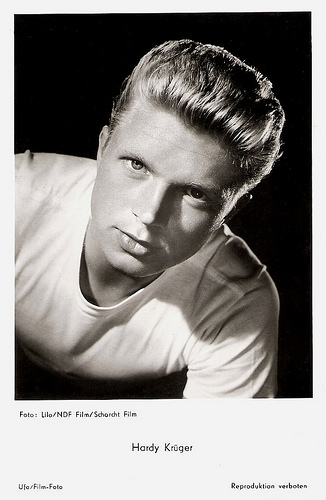
German postcard by Ufa Film-Foto, Berlin-Tempelhof, no. FK 1182. Photo: Lilo / NDF Film / Schorcht Film. Publicity still for Muss man sich gleich scheiden lassen?/Does one have to get divorced right away? (Hans Schweikart, 1953).
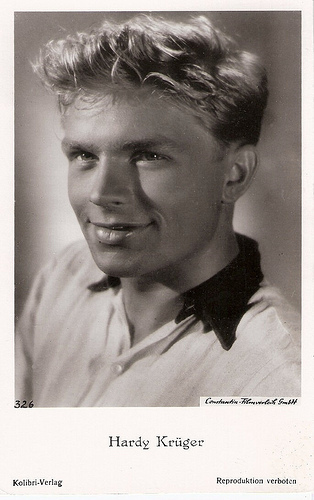
German postcard by Kolibri-Verlag G.m.b.H., Minden/Westf., no. 326. Photo: Constantin-Filmverleih GmbH.
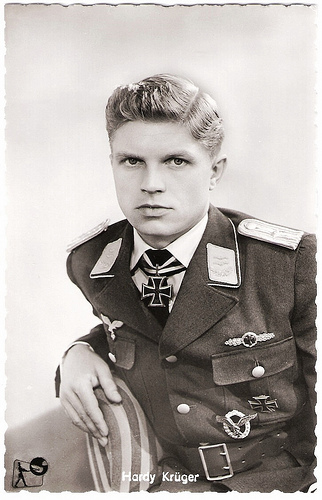
German postcard by Kolibri-Verlag G.m.b.H., Minden/Westf., no. 2727. Photo: Rank / Seeliger. Still for The One That Got Away (Roy Ward Baker, 1957).
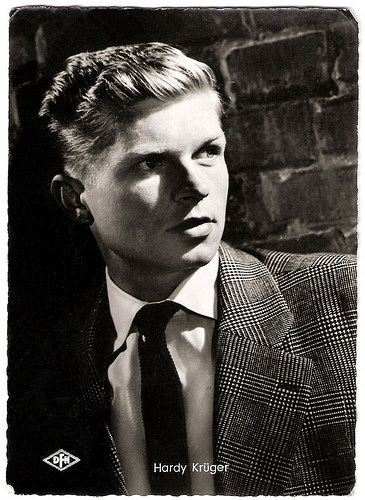
German postcard, no. 1251. Photo: Wesel / Berolina Film / Deutsche Film Hansa. Publicity still for Banktresor 713/Bank Vault 713 (Werner Klingler, 1957).
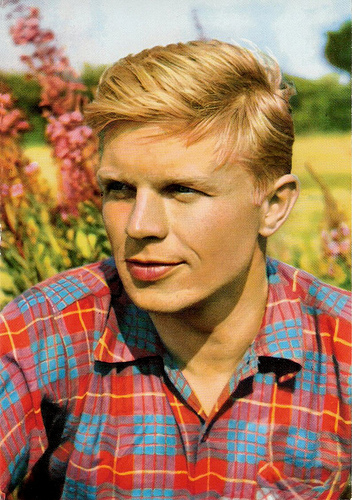
British postcard by East-West Publishers.
Young Eagle
Franz Eberhard August Krüger was born in 1928 in Berlin. He was the son of engineer Max Krüger.
From 1941 on Hardy attended the Adolf-Hitler-Schule at Burg Sonthofen, an elite Nazi boarding school. Here the blonde and handsome 15 year old was cast for the film Junge Adler/Young Eagles (Alfred Weidenmann, 1944) starring Willy Fritsch . This propagandafilm for the Wehrmacht was filmed in the huge Ufa studio in Babelsberg.
After his successful performance as the apprentice Bäumchen, director Wolfgang Liebeneiner tried to persuade him to continue his film career. In March 1945 the young Krüger was drafted into the SS Division 'Nibelungen', where he was drawn into heavy fighting before being captured by US forces in Tirol.
After his release he began to write but did not publish. Instead he started to perform in German theatres.
In 1949 he made his first post-war film, the comedy Diese Nacht vergess Ich nie/I'll Never Forget That Night (Johannes Meyer, 1949), with Gustav Fröhlich and Winnie Markus . In the following years his film career took off.
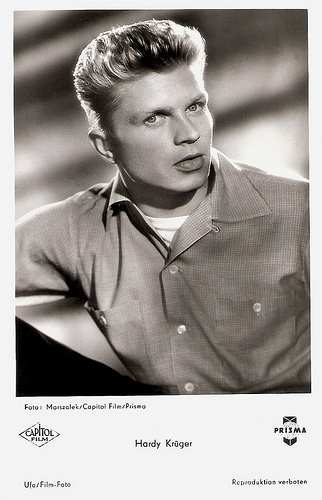
German postcard by Ufa Film-Foto, Berlin-Tempelhof, no. FK 1659. Photo: Marszalek / Capitol Film / Prisma.
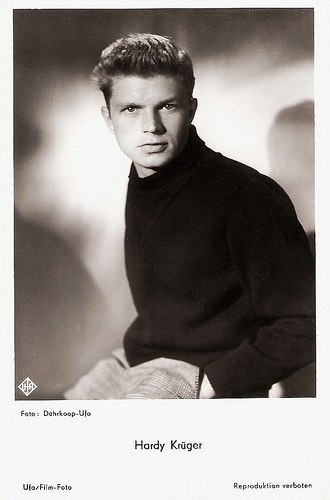
German postcard by Ufa Film-Foto, Berlin-Tempelhof, no. FK 3057. Photo: Dührkoop / Ufa.
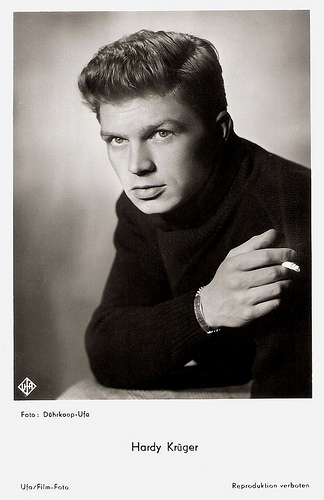
German postcard by Ufa Film-Foto, Berlin-Tempelhof, no. FK 3058. Photo: Dührkoop / Ufa.
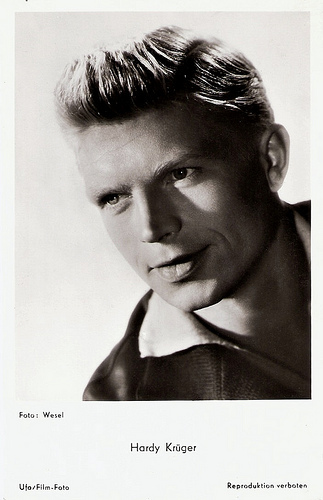
German postcard by Ufa Film-Foto, Berlin-Tempelhof, no. FK 3622. Photo: Wesel.
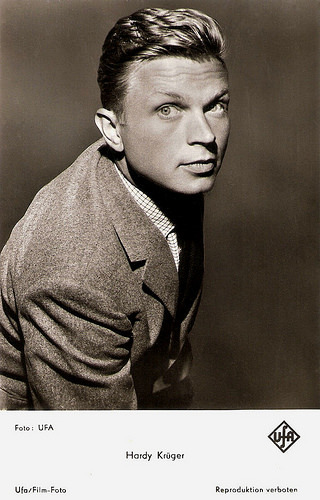
German postcard by Ufa, Berlin-Tempelhof, no. FK 4615. Photo: Ufa.
Effortlessly Natural Attitude
Hardy Krüger became known as a handsome young man with an effortlessly natural attitude in such films as Illusion in Moll/Illusion in a Minor Key (Rudolf Jugert, 1952) starring Hildegard Knef , the drama Solange Du da bist/As Long as You're Near Me (Harald Braun, 1953) with O.W. Fischer , and the comedy Die Jungfrau auf dem Dach/The Girl on the Roof (Otto Preminger, 1953) with Johannes Heesters .
The latter was the German version of the Hollywood production The Moon is Blue (Otto Preminger, 1953) starring William Holden and Maggie McNamara. Hardy Krüger and co-star Johanna Matz also appeared uncredited as tourists at the Empire State Building sequence in the American version.
The quality of some of his next films did not match his talents. And although the jungle fantasy Liane, das Mädchen aus dem Urwald/Liane, Jungle Goddess (Eduard von Borsody, 1956) with a briefly topless Marion Michael was one of the biggest German box office hits of the 1950s, he declined to star in further Liane films for 'artistic reasons'.
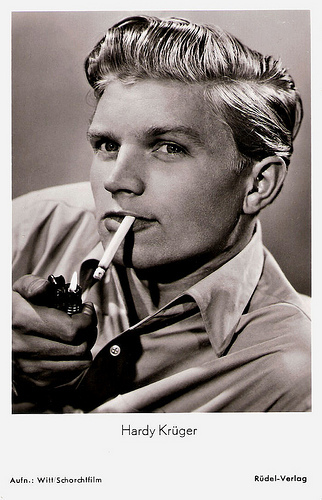
German postcard by Rüdel-Verlag, Hamburg-Bergedorf, no. 403. Photo: Witt / Schorchtfilm. Publicity still for Ich heisse Niki/My Name is Nicky (Rudolf Jugert, 1952).
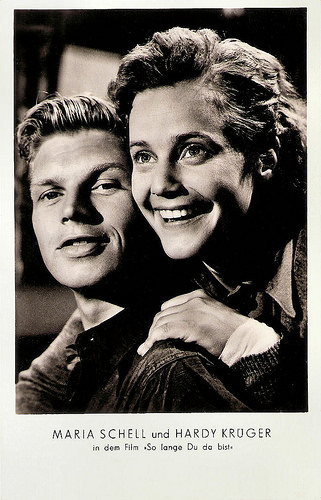
East-German postcard by Reichenbach, no. 691/56. Photo: NDF / Schorchtfilm. Publicity still for So lange Du da bist/As Long as You're Near Me (Harald Braun, 1953) with Maria Schell .
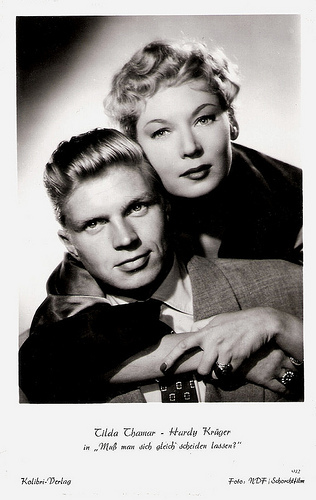
German postcard by Kolibri-Verlag, no. 912. Photo: NDF / Schorchtfilm. Publicity still for Muss man sich gleich scheiden lassen?/Does one have to get divorced right away? (Hans Schweikart, 1953) with Tilda Thamar.
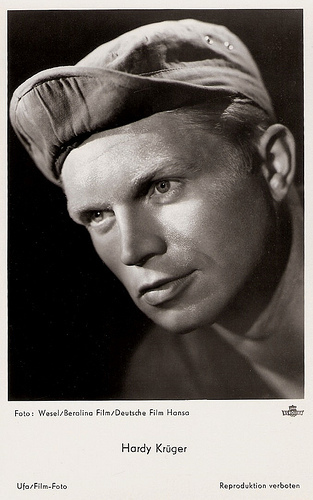
German postcard by Ufa Film-Foto, Berlin-Tempelhof, no. FK 3743. Photo: Wesel / Berolina Film / Deutsche Film Hansa. Publicity still for Banktresor 713/Bank Vault 713 (Werner Klingler, 1957)
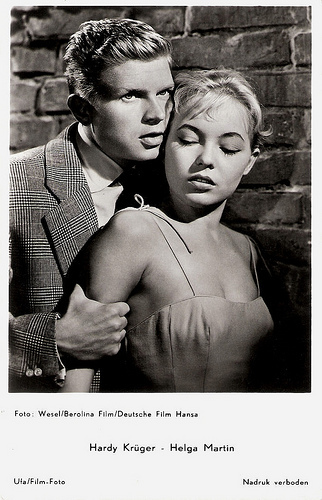
Dutch postcard by Gebr. Spanjersberg N.V., Rotterdam, no. 3747. Photo: Wesel / Berolina Film / Deutsche Film Hansa. Publicity still for Banktresor 713/Bank Vault 713 (Werner Klingler, 1957) with Helga Martin.
Soldiers and adventurers
Hardy Krüger is fluent in English, French and German, and found himself in demand by British, French, American and German producers.
J. Arthur Rank cast him in three British pictures practically filmed back-to-back. The first one was The One That Got Away (Roy Ward Baker, 1957), the story of the positive and unpolitical lieutenant Franz von Werra, the only German prisoner of war to successfully escape from numerous British POW camps during the Second World War and return to Germany.
The second was the comedy Bachelor of Hearts (Wolf Rilla, 1958), and the third the thriller Blind Date (Joseph Losey, 1959) with Stanley Baker and Micheline Presle . In reviews Hardy, was described as 'ruggedly handsome' and a 'blond heartthrob'.
Despite anti-German sentiment still prevailing in postwar Europe, he became an international favorite. He appeared in the German Shakespeare update Der Rest ist Schweigen/The Rest Is Silence (Helmut Käutner, 1959), and in the French WW II adventure Un taxi pour Tobrouk/Taxi for Tobruk (Denys de La Patellière, 1960).
A highlight was the French drama Les dimanches de Ville d'Avray/Sundays and Cybele (Serge Bourguignon, 1962). This hauntingly beautiful film about a platonic relationship between a former bomber pilot with a war trauma and amnesia, and a 12-year-old orphan girl (Patricia Gozzi), was awarded with the 1962 Best Foreign Film Academy Award. It paved Krüger's way to Hollywood.
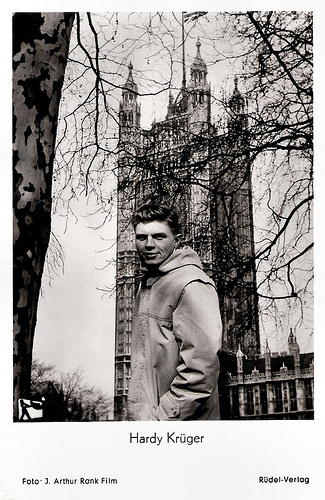
German postcard by Rüdel-Verlag, no. 2134. Photo: J. Arthur Rank Film. Publicity still for The One That Got Away (Roy Ward Baker, 1957).
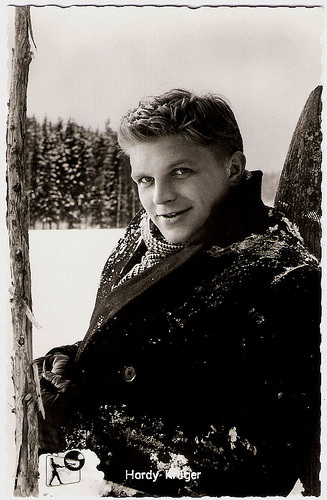
German postcard by Kolibri-Verlag, no. 2799. Photo: J. Arthur Rank Film. Publicity still for The One That Got Away (Roy Ward Baker, 1957).
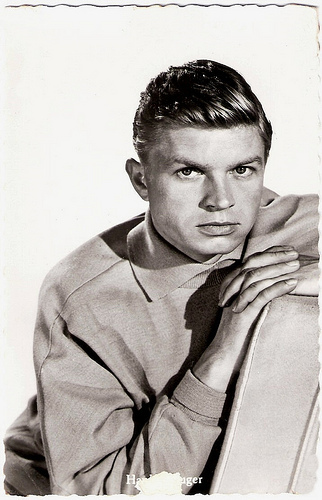
Dutch postcard by NV v.h. Weenenk & Snel, Baarn, no. 759. Photo: Rank Film for The One That Got Away (1957).

German postcard by Kolibri-Verlag G.m.b.H., Minden/Westf., no. 783. Photo: Rank. Still for Bachelor of Hearts (Wolf Rilla, 1958).
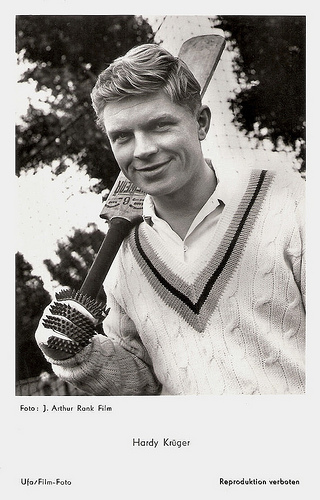
German postcard by Ufa, Berlin-Tempelhof, no. FK 4334. Photo: J. Arthur Rank Film. Publicity still for Bachelor of Hearts (Wolf Rilla, 1958).
Hollywood
In the USA, Hardy Krüger started in the African adventure Hatari! (Howard Hawks, 1962), at the side of John Wayne and Elsa Martinelli .
His later films included Hollywood productions like the original version of The Flight of the Phoenix (Robert Aldrich, 1965) about the survivors of a plane crash in the middle of the Sahara desert, and the war comedy-drama The Secret of Santa Vittoria (Stanley Kramer, 1969) with Anthony Quinn and Anna Magnani .
In the star studded war epic A Bridge Too Far (Richard Attenborough, 1977), he portrayed a Nazi General. Hardy Krüger related during the shooting how he hated to wear a Nazi uniform. Between takes he wore a topcoat over his SS uniform so as "not to remind myself of my childhood in Germany during WW II." Although he often played German soldiers, his characters were mostly positive, he personified the 'good German'.
Krüger also appeared in many European productions like Le Chant du monde/Song of the World (Marcel Camus, 1965) with Catherine Deneuve , the controversial box office hit La Monaca di Monza/The Nun of Monza (Eriprando Visconti, 1969) about a 17th-century Italian nun's long repressed sexual passion, the Italian-Russian coproduction Krasnaya palatka/The Red Tent (Mikhail Kalatozov, 1969) starring Sean Connery , and the murder mystery À chacun son enfer/To Each His Hell (André Cayatte, 1977) with Annie Girardot .
During that period, he made his sole appearance in a film of the New German Cinema in Peter Schamoni's comedy-western Potato Fritz/Montana Trap (Peter Schamoni, 1976).
Most memorable is his role as the Prussian Captain Potzdorf in the Oscar winner Barry Lyndon (Stanley Kubrick, 1975) featuring Ryan O'Neal. His last film appearance was in the Swedish-British thriller Slagskämpen/The Inside Man (Tom Clegg, 1984) starring Dennis Hopper .
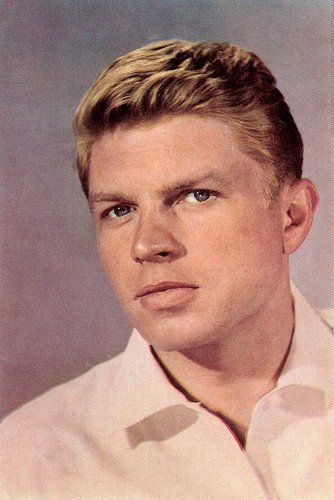
Belgian card by Cox, no. 35.
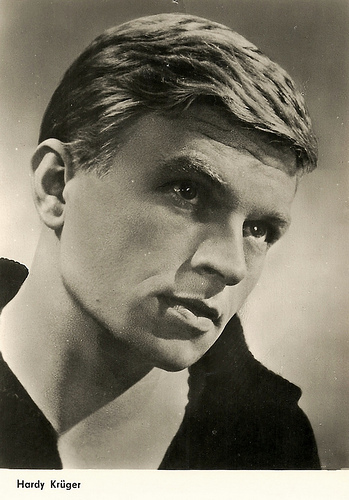
East-German postcard by VEB Progress Filmvertrieb. Starfoto, no. 1467. Photo: Hardy Krüger in the German-British film Alles spricht gegen van Rooyen/Blind Date (Joseph Losey, 1958-59).
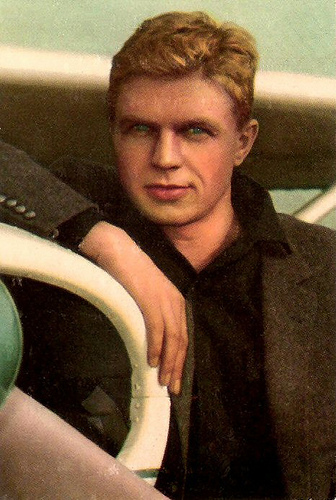
Belgian collector's card, no. 93.
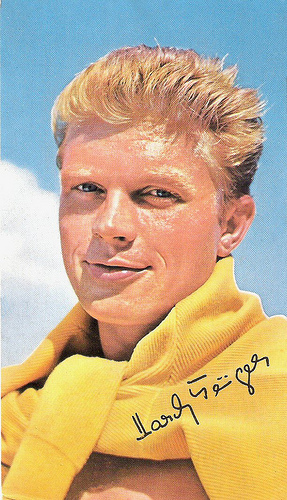
German collector's card by Luxor.
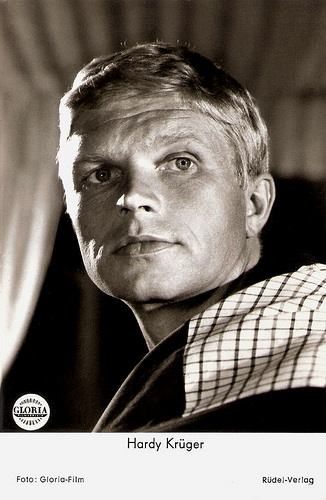
German postcard by Rüdel-Verlag, Hamburg, no. 4552. Photo: Gloria Film. Publicity still for Los pianos mecánicos/The Uninhibited (Juan Antonio Bardem, 1965).
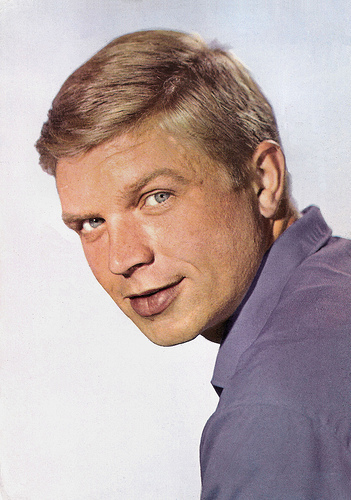
Spanish postcard by Postal Oscarcolor, no. 156.
A globe-trotter for TV
In the 1970s he had taken up writing fiction and non-fiction, and he started a new career as a globe trotter for TV. In 1983, after several novels, story collections, and a children's book he published the novel Junge Unrast, an only slighty disguised autobiographic account of his life.
On television, he played the role of Field Marshal Erwin Rommel in the popular American TV series War and Remembrance (Dan Curtis, 1989) starring Robert Mitchum. In 2011 appeared as the pater familias in the TV film Die Familie/The Family (Carlo Rola, 2011) with Gila von Weitershausen as his wife.
Hardy Krüger married three times. His marriages with actress Renate Densow and Italian painter Francesca Marazzi ended in a divorce. He married his current wife the American Anita Park in 1978. He has three children. His daughter by Renate Densow, Christiane Krüger (born in 1945, when he was only 17) and his son by Francesca Marazzi, Hardy Jr. Krüger are both actors too.
Hardy Krüger was awarded many times for his work. In 2001 he was made Officier de la Légion d’Honneur in France, and in 2009, Germany honoured him with the Großes Verdienstkreuz (Great Cross of Merit). Hardy and Anita Krüger live in a log cabin in Skyland, California, on top of Los Angeles, and in Hamburg.
American trailer for Liane, das Mädchen aus dem Urwald/Liane, Jungle Goddess (1956). Source: Sleaze-o-rama (YouTube).
Trailer for The One That Got Away (1957). Source: VCIClassicMovies (YouTube).
Hardy Krüger sings I'm A Lonely Man. From the film Blind Date (1959). Source: Rudi Polt (YouTube).
Trailer for Hatari (1962). Source: ParamountmoviesDigital (YouTube).
Trailer for Barry Lyndon (1975). Source: Vsible Movie Trailers (YouTube).
Sources: Hal Erickson (AllMovie), Stephanie D'heil (Steffi-line - German), (IMDb), Filmportal.de, Wikipedia and .

German postcard by Ufa Film-Foto, Berlin-Tempelhof, no. FK 1182. Photo: Lilo / NDF Film / Schorcht Film. Publicity still for Muss man sich gleich scheiden lassen?/Does one have to get divorced right away? (Hans Schweikart, 1953).

German postcard by Kolibri-Verlag G.m.b.H., Minden/Westf., no. 326. Photo: Constantin-Filmverleih GmbH.

German postcard by Kolibri-Verlag G.m.b.H., Minden/Westf., no. 2727. Photo: Rank / Seeliger. Still for The One That Got Away (Roy Ward Baker, 1957).

German postcard, no. 1251. Photo: Wesel / Berolina Film / Deutsche Film Hansa. Publicity still for Banktresor 713/Bank Vault 713 (Werner Klingler, 1957).

British postcard by East-West Publishers.
Young Eagle
Franz Eberhard August Krüger was born in 1928 in Berlin. He was the son of engineer Max Krüger.
From 1941 on Hardy attended the Adolf-Hitler-Schule at Burg Sonthofen, an elite Nazi boarding school. Here the blonde and handsome 15 year old was cast for the film Junge Adler/Young Eagles (Alfred Weidenmann, 1944) starring Willy Fritsch . This propagandafilm for the Wehrmacht was filmed in the huge Ufa studio in Babelsberg.
After his successful performance as the apprentice Bäumchen, director Wolfgang Liebeneiner tried to persuade him to continue his film career. In March 1945 the young Krüger was drafted into the SS Division 'Nibelungen', where he was drawn into heavy fighting before being captured by US forces in Tirol.
After his release he began to write but did not publish. Instead he started to perform in German theatres.
In 1949 he made his first post-war film, the comedy Diese Nacht vergess Ich nie/I'll Never Forget That Night (Johannes Meyer, 1949), with Gustav Fröhlich and Winnie Markus . In the following years his film career took off.

German postcard by Ufa Film-Foto, Berlin-Tempelhof, no. FK 1659. Photo: Marszalek / Capitol Film / Prisma.

German postcard by Ufa Film-Foto, Berlin-Tempelhof, no. FK 3057. Photo: Dührkoop / Ufa.

German postcard by Ufa Film-Foto, Berlin-Tempelhof, no. FK 3058. Photo: Dührkoop / Ufa.

German postcard by Ufa Film-Foto, Berlin-Tempelhof, no. FK 3622. Photo: Wesel.

German postcard by Ufa, Berlin-Tempelhof, no. FK 4615. Photo: Ufa.
Effortlessly Natural Attitude
Hardy Krüger became known as a handsome young man with an effortlessly natural attitude in such films as Illusion in Moll/Illusion in a Minor Key (Rudolf Jugert, 1952) starring Hildegard Knef , the drama Solange Du da bist/As Long as You're Near Me (Harald Braun, 1953) with O.W. Fischer , and the comedy Die Jungfrau auf dem Dach/The Girl on the Roof (Otto Preminger, 1953) with Johannes Heesters .
The latter was the German version of the Hollywood production The Moon is Blue (Otto Preminger, 1953) starring William Holden and Maggie McNamara. Hardy Krüger and co-star Johanna Matz also appeared uncredited as tourists at the Empire State Building sequence in the American version.
The quality of some of his next films did not match his talents. And although the jungle fantasy Liane, das Mädchen aus dem Urwald/Liane, Jungle Goddess (Eduard von Borsody, 1956) with a briefly topless Marion Michael was one of the biggest German box office hits of the 1950s, he declined to star in further Liane films for 'artistic reasons'.

German postcard by Rüdel-Verlag, Hamburg-Bergedorf, no. 403. Photo: Witt / Schorchtfilm. Publicity still for Ich heisse Niki/My Name is Nicky (Rudolf Jugert, 1952).

East-German postcard by Reichenbach, no. 691/56. Photo: NDF / Schorchtfilm. Publicity still for So lange Du da bist/As Long as You're Near Me (Harald Braun, 1953) with Maria Schell .

German postcard by Kolibri-Verlag, no. 912. Photo: NDF / Schorchtfilm. Publicity still for Muss man sich gleich scheiden lassen?/Does one have to get divorced right away? (Hans Schweikart, 1953) with Tilda Thamar.

German postcard by Ufa Film-Foto, Berlin-Tempelhof, no. FK 3743. Photo: Wesel / Berolina Film / Deutsche Film Hansa. Publicity still for Banktresor 713/Bank Vault 713 (Werner Klingler, 1957)

Dutch postcard by Gebr. Spanjersberg N.V., Rotterdam, no. 3747. Photo: Wesel / Berolina Film / Deutsche Film Hansa. Publicity still for Banktresor 713/Bank Vault 713 (Werner Klingler, 1957) with Helga Martin.
Soldiers and adventurers
Hardy Krüger is fluent in English, French and German, and found himself in demand by British, French, American and German producers.
J. Arthur Rank cast him in three British pictures practically filmed back-to-back. The first one was The One That Got Away (Roy Ward Baker, 1957), the story of the positive and unpolitical lieutenant Franz von Werra, the only German prisoner of war to successfully escape from numerous British POW camps during the Second World War and return to Germany.
The second was the comedy Bachelor of Hearts (Wolf Rilla, 1958), and the third the thriller Blind Date (Joseph Losey, 1959) with Stanley Baker and Micheline Presle . In reviews Hardy, was described as 'ruggedly handsome' and a 'blond heartthrob'.
Despite anti-German sentiment still prevailing in postwar Europe, he became an international favorite. He appeared in the German Shakespeare update Der Rest ist Schweigen/The Rest Is Silence (Helmut Käutner, 1959), and in the French WW II adventure Un taxi pour Tobrouk/Taxi for Tobruk (Denys de La Patellière, 1960).
A highlight was the French drama Les dimanches de Ville d'Avray/Sundays and Cybele (Serge Bourguignon, 1962). This hauntingly beautiful film about a platonic relationship between a former bomber pilot with a war trauma and amnesia, and a 12-year-old orphan girl (Patricia Gozzi), was awarded with the 1962 Best Foreign Film Academy Award. It paved Krüger's way to Hollywood.

German postcard by Rüdel-Verlag, no. 2134. Photo: J. Arthur Rank Film. Publicity still for The One That Got Away (Roy Ward Baker, 1957).

German postcard by Kolibri-Verlag, no. 2799. Photo: J. Arthur Rank Film. Publicity still for The One That Got Away (Roy Ward Baker, 1957).

Dutch postcard by NV v.h. Weenenk & Snel, Baarn, no. 759. Photo: Rank Film for The One That Got Away (1957).

German postcard by Kolibri-Verlag G.m.b.H., Minden/Westf., no. 783. Photo: Rank. Still for Bachelor of Hearts (Wolf Rilla, 1958).

German postcard by Ufa, Berlin-Tempelhof, no. FK 4334. Photo: J. Arthur Rank Film. Publicity still for Bachelor of Hearts (Wolf Rilla, 1958).
Hollywood
In the USA, Hardy Krüger started in the African adventure Hatari! (Howard Hawks, 1962), at the side of John Wayne and Elsa Martinelli .
His later films included Hollywood productions like the original version of The Flight of the Phoenix (Robert Aldrich, 1965) about the survivors of a plane crash in the middle of the Sahara desert, and the war comedy-drama The Secret of Santa Vittoria (Stanley Kramer, 1969) with Anthony Quinn and Anna Magnani .
In the star studded war epic A Bridge Too Far (Richard Attenborough, 1977), he portrayed a Nazi General. Hardy Krüger related during the shooting how he hated to wear a Nazi uniform. Between takes he wore a topcoat over his SS uniform so as "not to remind myself of my childhood in Germany during WW II." Although he often played German soldiers, his characters were mostly positive, he personified the 'good German'.
Krüger also appeared in many European productions like Le Chant du monde/Song of the World (Marcel Camus, 1965) with Catherine Deneuve , the controversial box office hit La Monaca di Monza/The Nun of Monza (Eriprando Visconti, 1969) about a 17th-century Italian nun's long repressed sexual passion, the Italian-Russian coproduction Krasnaya palatka/The Red Tent (Mikhail Kalatozov, 1969) starring Sean Connery , and the murder mystery À chacun son enfer/To Each His Hell (André Cayatte, 1977) with Annie Girardot .
During that period, he made his sole appearance in a film of the New German Cinema in Peter Schamoni's comedy-western Potato Fritz/Montana Trap (Peter Schamoni, 1976).
Most memorable is his role as the Prussian Captain Potzdorf in the Oscar winner Barry Lyndon (Stanley Kubrick, 1975) featuring Ryan O'Neal. His last film appearance was in the Swedish-British thriller Slagskämpen/The Inside Man (Tom Clegg, 1984) starring Dennis Hopper .

Belgian card by Cox, no. 35.

East-German postcard by VEB Progress Filmvertrieb. Starfoto, no. 1467. Photo: Hardy Krüger in the German-British film Alles spricht gegen van Rooyen/Blind Date (Joseph Losey, 1958-59).

Belgian collector's card, no. 93.

German collector's card by Luxor.

German postcard by Rüdel-Verlag, Hamburg, no. 4552. Photo: Gloria Film. Publicity still for Los pianos mecánicos/The Uninhibited (Juan Antonio Bardem, 1965).

Spanish postcard by Postal Oscarcolor, no. 156.
A globe-trotter for TV
In the 1970s he had taken up writing fiction and non-fiction, and he started a new career as a globe trotter for TV. In 1983, after several novels, story collections, and a children's book he published the novel Junge Unrast, an only slighty disguised autobiographic account of his life.
On television, he played the role of Field Marshal Erwin Rommel in the popular American TV series War and Remembrance (Dan Curtis, 1989) starring Robert Mitchum. In 2011 appeared as the pater familias in the TV film Die Familie/The Family (Carlo Rola, 2011) with Gila von Weitershausen as his wife.
Hardy Krüger married three times. His marriages with actress Renate Densow and Italian painter Francesca Marazzi ended in a divorce. He married his current wife the American Anita Park in 1978. He has three children. His daughter by Renate Densow, Christiane Krüger (born in 1945, when he was only 17) and his son by Francesca Marazzi, Hardy Jr. Krüger are both actors too.
Hardy Krüger was awarded many times for his work. In 2001 he was made Officier de la Légion d’Honneur in France, and in 2009, Germany honoured him with the Großes Verdienstkreuz (Great Cross of Merit). Hardy and Anita Krüger live in a log cabin in Skyland, California, on top of Los Angeles, and in Hamburg.
American trailer for Liane, das Mädchen aus dem Urwald/Liane, Jungle Goddess (1956). Source: Sleaze-o-rama (YouTube).
Trailer for The One That Got Away (1957). Source: VCIClassicMovies (YouTube).
Hardy Krüger sings I'm A Lonely Man. From the film Blind Date (1959). Source: Rudi Polt (YouTube).
Trailer for Hatari (1962). Source: ParamountmoviesDigital (YouTube).
Trailer for Barry Lyndon (1975). Source: Vsible Movie Trailers (YouTube).
Sources: Hal Erickson (AllMovie), Stephanie D'heil (Steffi-line - German), (IMDb), Filmportal.de, Wikipedia and .
Published on June 25, 2015 22:00
June 24, 2015
Magali Noël (1931-2015)
Last Tuesday, 23 June 2015, Turkish-French actress and singer Magali Noël has died. She acted in French and Italian films between 1951 and 2002. The sexy actress was an object of desire in three masterpieces of Federico Fellini. As a singer she had one of the first French Rock & Roll hits, which was forbidden for a long time because of its risqué lyrics. Magali Noël was 83.
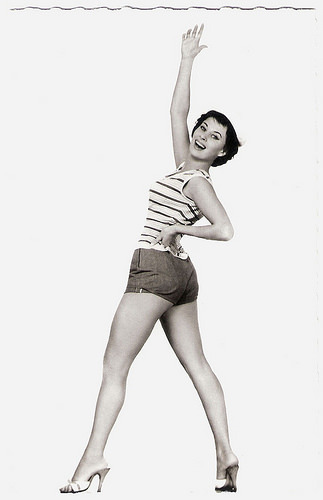
French postcard by Editions du Globe, Paris, no. 866. Photo: Sam Lévin.

French postcard by Editions du Globe, Paris, no. 414. Photo: Sam Lévin.
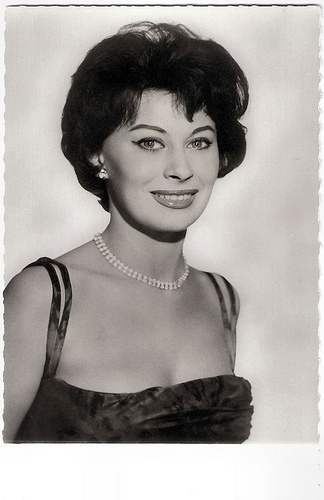
French postcard by Editions P.I., no. 958, offered by Les carbones Korès 'Carboplane'. Photo: Sam Lévin.

French postcard by Editions P.I., Paris, no. 1010. Photo: Sam Lévin.
Hurt me Johnny
Magali Noël was born Magali Noëlle Guiffray in Izmir, Turkey in 1932. At the age of seven, she emigrated with her family from Turkey to France in 1939.
She studied singing, music and dance, and at age 16 she made her first appearance as a cabaret singer and then occurred in revues. She also studied drama with Catherine Fontenay and then appeared in her first stage plays. In 1951 her film career began with parts in the comedies Demain nous divorçons/Tomorrow we divorce (Louis Cuny, 1951) with Sophie Desmarets , and Seul dans Paris/Alone in Paris (Hervé Bromberger, 1951) as the young wife of Bourvil .
She was noticed for the first time when she appeared in the Film Noir Du rififi chez les hommes/Rififi (Jules Dassin, 1955) starring Jean Servais . James Travers at Films de France : “As the film’s stunning femme fatale, the actress Magali Noël had her big break, which would lead her to be cast by Federico Fellini in La Dolce Vita (1960) and two subsequent films. It is Noël who sings the film’s notorious (and often unfairly reviled) musical number, which explains what the slang word Rififi means - a violent confrontation between rival gangs.”
She showed that she was a luscious actress with a fiery temperament in films like Razzia sur la chnouf/Razzia (Henri Decoin, 1955) with Jean Gabin , Les Grandes Manœuvres/The Grand Maneuver (René Clair, 1955) with Gérard Philippe , and Elena et les homes/Paris Does Strange Things (Jean Renoir, 1956) featuring Ingrid Bergman .
In 1956, her recording career began in France, and her most famous song was Fais-moi mal, Johnny (Hurt me Johnny), written by Boris Vian. This song was one of the first Rock & Roll songs with French lyrics. It was forbidden on the radio for a long time due to its risqué lyrics describing – with a great sense of humour and derision – a sadomasochistic episode.
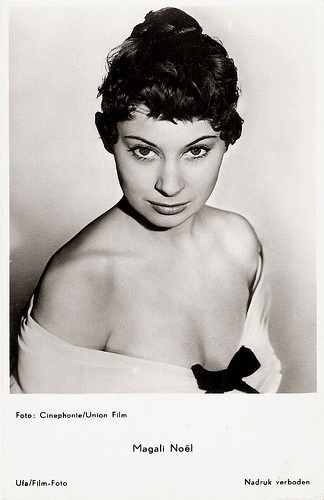
Belgian-Dutch postcard by D.R.C., no. 1393. Licency holder for Ufa. Photo: Cinephonie / Union Film.

Italian postcard by Foto S.P.E.S., Roma, no. 648. Photo: E.R.A. Cinematografica. Publicity still for E arrivata la parigina/The Parisienne has arrived (Camillo Mastrocinque, 1958).
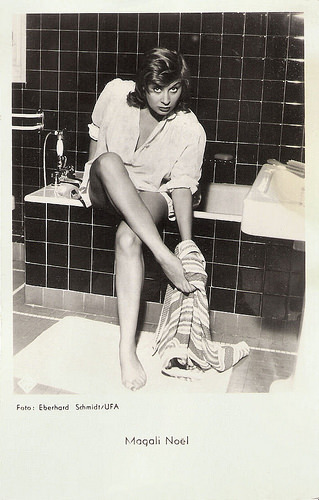
French postcard by Editions P.I., Paris, no. FK 3336. Photo: Eberhardt Schmidt / Ufa.
A symbol of Fellini's sexual fantasies
Magali Noël’s film career took a new turn when she appeared as Fanny in Federico Fellini's La Dolce Vita (1960) starring Marcello Mastroianni . She later was again a symbol of sexual fantasies as Fortunata in Satyricon (1969) and especially in Amarcord (1973).
In Amarcord, Noël played a sexy provincial hairdresser with the evocative nickname Gradisca (Taste it). Robert Firsching at AllMovie : “Federico Fellini's warmly nostalgic memory piece examines daily life in the Italian village of Rimini during the reign of Mussolini, and won the 1974 Academy Award as Best Foreign Film. The film's greatest asset is its ability to be sweet without being cloying, due in great part to Danilo Donati's surrealistic art direction and to the frequently bawdy injections of sex and politics by screenwriters Fellini and Tonino Guerra. Fellini clearly has deep affection for the people of this seaside village, warts and all, and communicates it through episodic visual anecdotes which are seen as if through the mists of a favourite dream”.
Noël also had a key role in another masterpiece, Costa Gravas’ political thriller Z (1968), which won the Palme d’Or in Cannes, Dan Pavlides at AllMovie : “Z won the Oscar for Best Foreign Film of 1969, was 14th in terms of box-office success, and hit an international nerve in the age of social unrest, government cover-up, and political assassinations. All those involved worked on the film for a reduced rate with an option for royalties based on earnings at the theater window. The letter Z in the Greek alphabet means ‘he is alive’.”
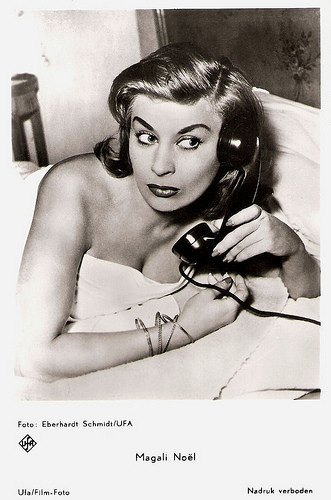
Belgian postcard by D.R.C. Holland, no. 3336. Photo: Eberhardt Schmidt / Ufa.
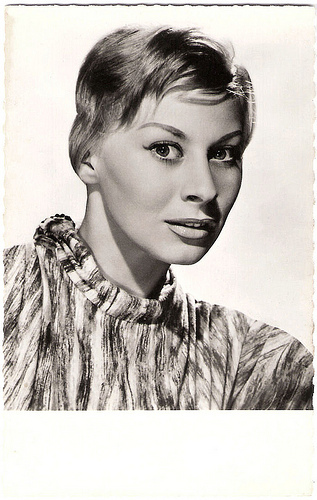
French postcard by Editions P.I., no. 897. Photo: Lucienne Chevert.
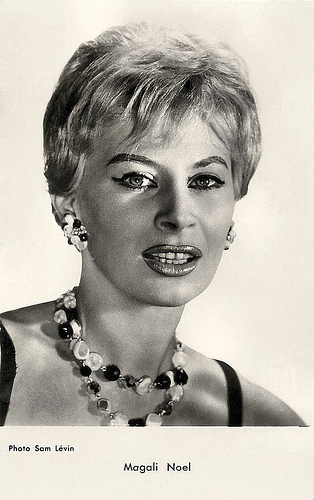
French postcard by Editions P.I., Paris. Offered by Les Carbones Korès, no. 1115. Photo: Sam Lévin.
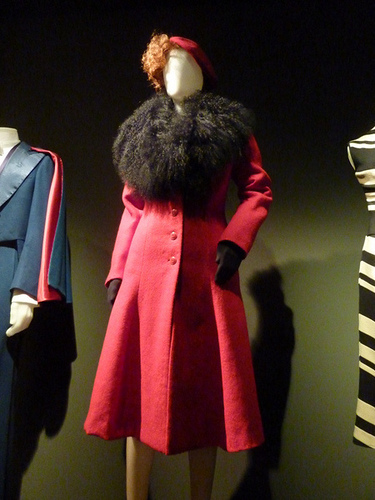
Costume of Magali Noël (Gradisca) in Amarcord (Federico Fellini 1973) at a costume exhibition in Cinecittà, Roma. Photo: Bob, Truus & Jan Too!@Flickr.
Successful return to the music-hall
Despite Magali Noël's work for Fellini and Costa-Gravas, producers offered her less work. So she returned successfully to the music-hall. Later a new generation of directors started to offer her roles. Among her later films are Les Rendez-vous d’Anna/Anna's Meetings (Chantal Akerman, 1978), Le chemin perdu/The lost way (Patricia Moraz, 1980) with Charles Vanel , and La Mort de Mario Ricci/The Death of Mario Ricci (Claude Goretta, 1982) featuring Gian Maria Volonté.
From 1980 on, her career extended to television films. Among her later feature films are La Fidélité/Fidelity (Andrzej Zulawski, 2000) as the mother of Sophie Marceau, and the thriller The Truth About Charlie (Jonathan Demme, 2002) with Mark Wahlberg. Magali Noël’s last film appearance was in Rien que du bonheur (Denis Parent, 2003).
Magali Noël had a daughter with actor Jean-Pierre Bernard, and two sons, who she had adopted when she remarried. She died in the retirement home in Chateauneuf-Grasse where she lived.
Magali Noël and Boris Vian sing Fais moi mal Johnny. Source: marco17220 (YouTube).
Magali Noël sings Le Rififi in Du rififi chez les hommes/Rififi (1955). Source: Dive Italiane (YouTube).
Italian trailer for Totò e Cleopatra (1963). Source: Film&Clips (YouTube).
Trailer Amarcord (1973). Source: Danios12345 (YouTube).
Sources: James Travers (Films de France), Hal Erickson (AllMovie), Robert Firsching (AllMovie), Dan Pavlides (AllMovie), Le Monde (French), Magali Noël.ch (French in archive), Wikipedia and .

French postcard by Editions du Globe, Paris, no. 866. Photo: Sam Lévin.

French postcard by Editions du Globe, Paris, no. 414. Photo: Sam Lévin.

French postcard by Editions P.I., no. 958, offered by Les carbones Korès 'Carboplane'. Photo: Sam Lévin.

French postcard by Editions P.I., Paris, no. 1010. Photo: Sam Lévin.
Hurt me Johnny
Magali Noël was born Magali Noëlle Guiffray in Izmir, Turkey in 1932. At the age of seven, she emigrated with her family from Turkey to France in 1939.
She studied singing, music and dance, and at age 16 she made her first appearance as a cabaret singer and then occurred in revues. She also studied drama with Catherine Fontenay and then appeared in her first stage plays. In 1951 her film career began with parts in the comedies Demain nous divorçons/Tomorrow we divorce (Louis Cuny, 1951) with Sophie Desmarets , and Seul dans Paris/Alone in Paris (Hervé Bromberger, 1951) as the young wife of Bourvil .
She was noticed for the first time when she appeared in the Film Noir Du rififi chez les hommes/Rififi (Jules Dassin, 1955) starring Jean Servais . James Travers at Films de France : “As the film’s stunning femme fatale, the actress Magali Noël had her big break, which would lead her to be cast by Federico Fellini in La Dolce Vita (1960) and two subsequent films. It is Noël who sings the film’s notorious (and often unfairly reviled) musical number, which explains what the slang word Rififi means - a violent confrontation between rival gangs.”
She showed that she was a luscious actress with a fiery temperament in films like Razzia sur la chnouf/Razzia (Henri Decoin, 1955) with Jean Gabin , Les Grandes Manœuvres/The Grand Maneuver (René Clair, 1955) with Gérard Philippe , and Elena et les homes/Paris Does Strange Things (Jean Renoir, 1956) featuring Ingrid Bergman .
In 1956, her recording career began in France, and her most famous song was Fais-moi mal, Johnny (Hurt me Johnny), written by Boris Vian. This song was one of the first Rock & Roll songs with French lyrics. It was forbidden on the radio for a long time due to its risqué lyrics describing – with a great sense of humour and derision – a sadomasochistic episode.

Belgian-Dutch postcard by D.R.C., no. 1393. Licency holder for Ufa. Photo: Cinephonie / Union Film.

Italian postcard by Foto S.P.E.S., Roma, no. 648. Photo: E.R.A. Cinematografica. Publicity still for E arrivata la parigina/The Parisienne has arrived (Camillo Mastrocinque, 1958).

French postcard by Editions P.I., Paris, no. FK 3336. Photo: Eberhardt Schmidt / Ufa.
A symbol of Fellini's sexual fantasies
Magali Noël’s film career took a new turn when she appeared as Fanny in Federico Fellini's La Dolce Vita (1960) starring Marcello Mastroianni . She later was again a symbol of sexual fantasies as Fortunata in Satyricon (1969) and especially in Amarcord (1973).
In Amarcord, Noël played a sexy provincial hairdresser with the evocative nickname Gradisca (Taste it). Robert Firsching at AllMovie : “Federico Fellini's warmly nostalgic memory piece examines daily life in the Italian village of Rimini during the reign of Mussolini, and won the 1974 Academy Award as Best Foreign Film. The film's greatest asset is its ability to be sweet without being cloying, due in great part to Danilo Donati's surrealistic art direction and to the frequently bawdy injections of sex and politics by screenwriters Fellini and Tonino Guerra. Fellini clearly has deep affection for the people of this seaside village, warts and all, and communicates it through episodic visual anecdotes which are seen as if through the mists of a favourite dream”.
Noël also had a key role in another masterpiece, Costa Gravas’ political thriller Z (1968), which won the Palme d’Or in Cannes, Dan Pavlides at AllMovie : “Z won the Oscar for Best Foreign Film of 1969, was 14th in terms of box-office success, and hit an international nerve in the age of social unrest, government cover-up, and political assassinations. All those involved worked on the film for a reduced rate with an option for royalties based on earnings at the theater window. The letter Z in the Greek alphabet means ‘he is alive’.”

Belgian postcard by D.R.C. Holland, no. 3336. Photo: Eberhardt Schmidt / Ufa.

French postcard by Editions P.I., no. 897. Photo: Lucienne Chevert.

French postcard by Editions P.I., Paris. Offered by Les Carbones Korès, no. 1115. Photo: Sam Lévin.

Costume of Magali Noël (Gradisca) in Amarcord (Federico Fellini 1973) at a costume exhibition in Cinecittà, Roma. Photo: Bob, Truus & Jan Too!@Flickr.
Successful return to the music-hall
Despite Magali Noël's work for Fellini and Costa-Gravas, producers offered her less work. So she returned successfully to the music-hall. Later a new generation of directors started to offer her roles. Among her later films are Les Rendez-vous d’Anna/Anna's Meetings (Chantal Akerman, 1978), Le chemin perdu/The lost way (Patricia Moraz, 1980) with Charles Vanel , and La Mort de Mario Ricci/The Death of Mario Ricci (Claude Goretta, 1982) featuring Gian Maria Volonté.
From 1980 on, her career extended to television films. Among her later feature films are La Fidélité/Fidelity (Andrzej Zulawski, 2000) as the mother of Sophie Marceau, and the thriller The Truth About Charlie (Jonathan Demme, 2002) with Mark Wahlberg. Magali Noël’s last film appearance was in Rien que du bonheur (Denis Parent, 2003).
Magali Noël had a daughter with actor Jean-Pierre Bernard, and two sons, who she had adopted when she remarried. She died in the retirement home in Chateauneuf-Grasse where she lived.
Magali Noël and Boris Vian sing Fais moi mal Johnny. Source: marco17220 (YouTube).
Magali Noël sings Le Rififi in Du rififi chez les hommes/Rififi (1955). Source: Dive Italiane (YouTube).
Italian trailer for Totò e Cleopatra (1963). Source: Film&Clips (YouTube).
Trailer Amarcord (1973). Source: Danios12345 (YouTube).
Sources: James Travers (Films de France), Hal Erickson (AllMovie), Robert Firsching (AllMovie), Dan Pavlides (AllMovie), Le Monde (French), Magali Noël.ch (French in archive), Wikipedia and .
Published on June 24, 2015 15:00
June 23, 2015
Imported from the USA: Sessue Hayakawa
Sessue Hayakawa (1889–1973) was a Japanese actor who starred in more than 80 American, Japanese, French, German, and British films. He was the first Asian actor to find stardom first in Hollywood and later in Europe. His 'broodingly handsome' good looks and typecasting as a sinister villain with sexual dominance made him a heartthrob among female audiences in the 1910s and early 1920s. Nowadays he is best remembered for his Oscar-nominated turn as Japanese POW camp commander Saito in The Bridge on the River Kwai (1957).
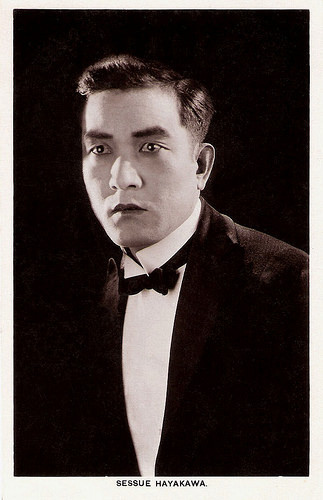
British Real Photograph postcard in the Picturegoer Series, London, no. 224.
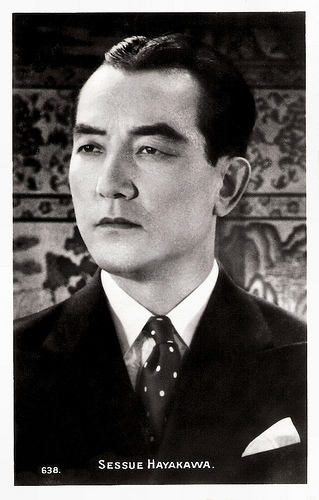
French card, no. 638.
The Cheat
Sessue Hayakawa (早川 雪洲) was born Kintaro Hayakawa in the village of Nanaura, now part of the city of Minamibosō in Japan in 1889. His father was the provincial governor and his mother a member of an aristocratic family of the 'samurai' class. The young Hayakawa wanted to become a career officer in the Japanese navy, but he was turned down due to problems with his hearing.
He studied political economics at the University of Chicago to fulfil his family's wish that he become a banker. After his second year of studies at the University of Chicago, Hayakawa decided to quit school and return to Japan. He travelled to Los Angeles and during his stay, he discovered the Japanese Theatre in Little Tokyo and became fascinated with acting and performing plays. It was around this time that he assumed the name Sessue Hayakawa.
One of the productions in which Hayakawa performed was called The Typhoon. Legendary producer-director Thomas Ince saw the production and offered to turn it into a silent movie with the original cast. The Typhoon (Reginald Barker, 1914) became an instant hit and was followed by two additional pictures produced by Ince, The Wrath of the Gods (Reginald Barker, 1914) co-starring his new wife, actress Tsuru Aoki, and The Sacrifice (?, 1914). With Hayakawa's rising stardom, Jesse L. Lasky offered Hayakawa a contract at Famous Players-Lasky (now Paramount Pictures).
Hayakawa's second film for Famous Players-Lasky, The Cheat (Cecil B. DeMille, 1915) with Fannie Ward, was a huge success. Again, he distinguished himself by giving a naturalistic performance. Following The Cheat, Hayakawa became a top leading man for romantic dramas in the 1910s and early 1920s.
His 'broodingly handsome' good looks and typecasting as a sinister villain with sexual dominance made him a heartthrob among American women, and the first male sex symbol of Hollywood, several years before Rudolph Valentino. He became one of the highest paid stars of his time, earning $5,000 per week in 1915, and $2 million per year through his own production company, Haworth Pictures, during the 1920s.
Wikipedia : "During the height of his popularity, critics hailed Hayakawa's Zen-influenced acting style. Hayakawa sought to bring muga, or the 'absence of doing,' to his performances, in direct contrast to the then-popular studied poses and broad gestures. He was one of the first stars to do so, Mary Pickford being another."
Hayakawa and wife Tsuru Aoki lived in a landmark home, built in the style of a French castle. He drove a gold plated Pierce-Arrow and entertained lavishly in his 'Castle' which was known as the scene of some of Hollywood's wildest parties. But in 1923, his waning popularity and a bad business deal forced Hayakawa to leave Hollywood.
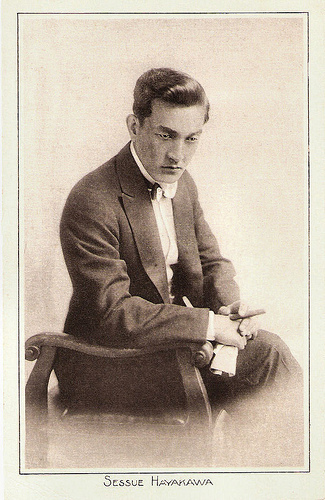
British postcard in the Pictures Portrait Gallery by Pictures Ltd, London, no. 45.
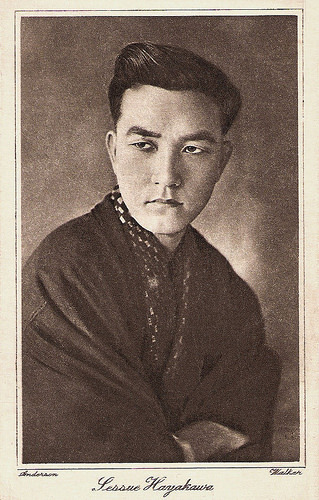
British postcard. Photo: Anderson / Walker.
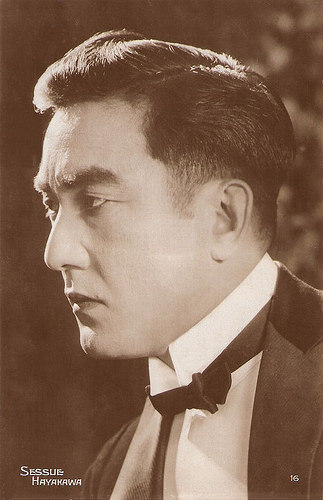
French postcard by Cinémagazine-Edition, no. 16.
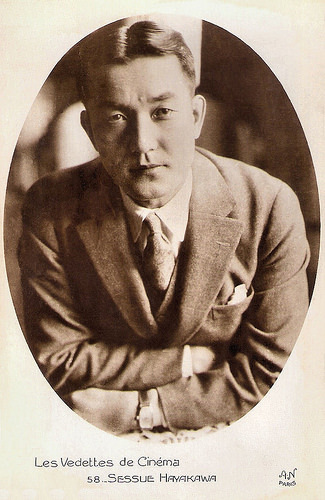
French postcard in the series Les Vedettes de Cinéma by A.N., Paris, no. 58.
Yoshiwara
The next 15 years Sessue Hayakawa performed in New York, in Europe and in Japan. In France, he starred in La bataille/The Battle (Sessue Hayakawa, Édouard-Émile Violet, 1923), a popular melodrama spiced with martial arts. He also appeared in the French crime drama J'ai tué!/I Have Killed (Roger Lion, 1924) with Huguette Duflos .
In the UK, he made Sen Yan's Devotion (A.E. Coleby, 1924) and The Great Prince Shan (A.E. Coleby, 1924) with Ivy Duke. In 1925, he wrote a novel, The Bandit Prince, and adapted it into a short play. In 1930, he performed in Samurai, a one-act play written especially for him, for Great Britain's King George V and Queen Mary,
In 1931 Hayakawa returned to Hollywood to make his talking-picture debut playing Fu Manchu in Daughter of the Dragon (Lloyd Corrigan 1931), featuring Anna May Wong . Sound revealed that he had a heavy accent, and his acting got poor reviews.
He returned to Japan where he made a series of films before once again going to France. There he made the geisha melodrama Yoshiwara (Max Ophüls, 1937) with Pierre Richard-Willm . He also appeared in a French remake of The Cheat called Forfaiture (Marcel L'Herbier, 1937), playing the same role that over 20 year earlier had made him one of the biggest stars in the world.
Sessue Hayakawa played a Samurai in the German-Japanese co-production Atarashiki tsuchi/The New Earth (1937), which was co-directed by Arnold Fanck and Mansaku Itami.
Later, he found himself trapped and separated from his family, when the Germans occupied France in 1940. Hayakawa made few films during these years, but supported himself by selling watercolours. He joined the French Resistance and helped Allied flyers during the war.
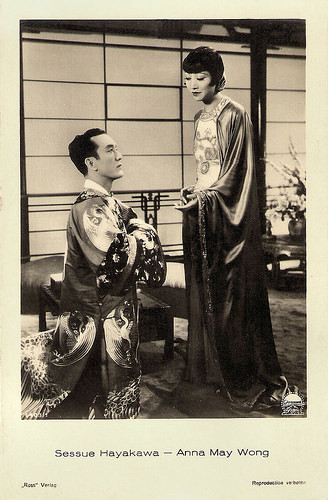
German postcard by Ross Verlag, no. 6403/1, 1931-1932. Photo: Paramount. Publicity still for Daughter of the Dragon (Lloyd Corrigan, 1931) with Anna May Wong .
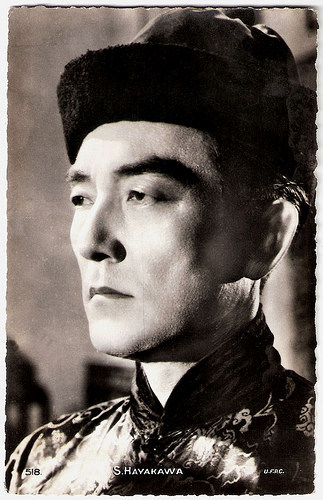
French postcard by Edit. Chantal, no. 518. Photo: U.F.S.C.
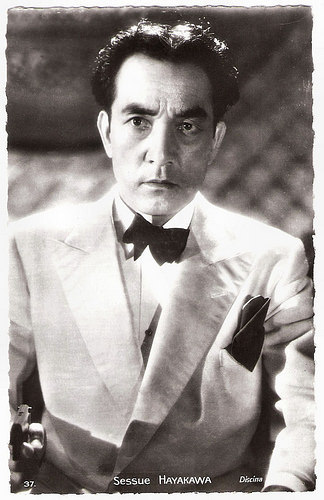
French card, no. 37. Photo: Discina.
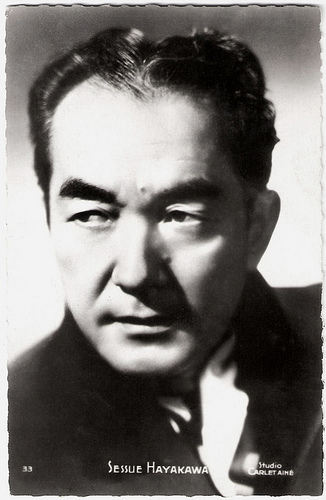
French postcard. Photo: Studio Carlet ainé, no. 33.
The Bridge on the River Kwai
After the war, Sessue Hayakawa's friendships with American actors led him to return to Hollywood. In 1949, Humphrey Bogart's production company located Hayakawa and offered him a role in Tokyo Joe (Stuart Heisler, 1949). Before issuing a work permit, the American Consulate investigated Hayakawa's activities during the war and found that he had in no way contributed to the German war effort.
Hayakawa followed Tokyo Joe with Three Came Home (Jean Negulesco, 1950), in which he played real-life POW camp commander Lieutenant-Colonel Suga, opposite Claudette Colbert. He had re-established himself as a character actor.
His on-screen roles of the 1950s can best be described as the honourable villain, a figure exemplified by his portrayal of Colonel Saito in The Bridge on the River Kwai (David Lean, 1957). The film won the 1957 Academy Award for Best Picture and Hayakawa received a nomination for Best Supporting Actor, losing to Red Buttons. He was also nominated for a Golden Globe for the role that he called the highlight of his career.
After that film, Hayakawa largely retired from acting. Throughout the rest of his life he performed on a handful of television shows and a few films. He played the pirate leader in Disney's Swiss Family Robinson (Ken Annakin, 1960) and his final film appearance was in the Japanese film Junjô nijûsô (1967).
Sessue Hayakawa retired from film in 1966. After his wife's death he returned to Japan where he became a Zen master and a drama coach. He authored his autobiography, Zen Showed Me the Way, and appeared on the NBC interview program Here's Hollywood. Hayakawa died in Tokyo in 1973, from a cerebral thrombosis, complicated by pneumonia.
Scene from The Cheat (1915). Source: Kopernikanische Wende (YouTube).
Trailer The Bridge on the River Kwai (1957). Source: SuperUnknown (YouTube).
Source: (IMDb), Sandra Brennan (AllMovie), Wikipedia and .

British Real Photograph postcard in the Picturegoer Series, London, no. 224.

French card, no. 638.
The Cheat
Sessue Hayakawa (早川 雪洲) was born Kintaro Hayakawa in the village of Nanaura, now part of the city of Minamibosō in Japan in 1889. His father was the provincial governor and his mother a member of an aristocratic family of the 'samurai' class. The young Hayakawa wanted to become a career officer in the Japanese navy, but he was turned down due to problems with his hearing.
He studied political economics at the University of Chicago to fulfil his family's wish that he become a banker. After his second year of studies at the University of Chicago, Hayakawa decided to quit school and return to Japan. He travelled to Los Angeles and during his stay, he discovered the Japanese Theatre in Little Tokyo and became fascinated with acting and performing plays. It was around this time that he assumed the name Sessue Hayakawa.
One of the productions in which Hayakawa performed was called The Typhoon. Legendary producer-director Thomas Ince saw the production and offered to turn it into a silent movie with the original cast. The Typhoon (Reginald Barker, 1914) became an instant hit and was followed by two additional pictures produced by Ince, The Wrath of the Gods (Reginald Barker, 1914) co-starring his new wife, actress Tsuru Aoki, and The Sacrifice (?, 1914). With Hayakawa's rising stardom, Jesse L. Lasky offered Hayakawa a contract at Famous Players-Lasky (now Paramount Pictures).
Hayakawa's second film for Famous Players-Lasky, The Cheat (Cecil B. DeMille, 1915) with Fannie Ward, was a huge success. Again, he distinguished himself by giving a naturalistic performance. Following The Cheat, Hayakawa became a top leading man for romantic dramas in the 1910s and early 1920s.
His 'broodingly handsome' good looks and typecasting as a sinister villain with sexual dominance made him a heartthrob among American women, and the first male sex symbol of Hollywood, several years before Rudolph Valentino. He became one of the highest paid stars of his time, earning $5,000 per week in 1915, and $2 million per year through his own production company, Haworth Pictures, during the 1920s.
Wikipedia : "During the height of his popularity, critics hailed Hayakawa's Zen-influenced acting style. Hayakawa sought to bring muga, or the 'absence of doing,' to his performances, in direct contrast to the then-popular studied poses and broad gestures. He was one of the first stars to do so, Mary Pickford being another."
Hayakawa and wife Tsuru Aoki lived in a landmark home, built in the style of a French castle. He drove a gold plated Pierce-Arrow and entertained lavishly in his 'Castle' which was known as the scene of some of Hollywood's wildest parties. But in 1923, his waning popularity and a bad business deal forced Hayakawa to leave Hollywood.

British postcard in the Pictures Portrait Gallery by Pictures Ltd, London, no. 45.

British postcard. Photo: Anderson / Walker.

French postcard by Cinémagazine-Edition, no. 16.

French postcard in the series Les Vedettes de Cinéma by A.N., Paris, no. 58.
Yoshiwara
The next 15 years Sessue Hayakawa performed in New York, in Europe and in Japan. In France, he starred in La bataille/The Battle (Sessue Hayakawa, Édouard-Émile Violet, 1923), a popular melodrama spiced with martial arts. He also appeared in the French crime drama J'ai tué!/I Have Killed (Roger Lion, 1924) with Huguette Duflos .
In the UK, he made Sen Yan's Devotion (A.E. Coleby, 1924) and The Great Prince Shan (A.E. Coleby, 1924) with Ivy Duke. In 1925, he wrote a novel, The Bandit Prince, and adapted it into a short play. In 1930, he performed in Samurai, a one-act play written especially for him, for Great Britain's King George V and Queen Mary,
In 1931 Hayakawa returned to Hollywood to make his talking-picture debut playing Fu Manchu in Daughter of the Dragon (Lloyd Corrigan 1931), featuring Anna May Wong . Sound revealed that he had a heavy accent, and his acting got poor reviews.
He returned to Japan where he made a series of films before once again going to France. There he made the geisha melodrama Yoshiwara (Max Ophüls, 1937) with Pierre Richard-Willm . He also appeared in a French remake of The Cheat called Forfaiture (Marcel L'Herbier, 1937), playing the same role that over 20 year earlier had made him one of the biggest stars in the world.
Sessue Hayakawa played a Samurai in the German-Japanese co-production Atarashiki tsuchi/The New Earth (1937), which was co-directed by Arnold Fanck and Mansaku Itami.
Later, he found himself trapped and separated from his family, when the Germans occupied France in 1940. Hayakawa made few films during these years, but supported himself by selling watercolours. He joined the French Resistance and helped Allied flyers during the war.

German postcard by Ross Verlag, no. 6403/1, 1931-1932. Photo: Paramount. Publicity still for Daughter of the Dragon (Lloyd Corrigan, 1931) with Anna May Wong .

French postcard by Edit. Chantal, no. 518. Photo: U.F.S.C.

French card, no. 37. Photo: Discina.

French postcard. Photo: Studio Carlet ainé, no. 33.
The Bridge on the River Kwai
After the war, Sessue Hayakawa's friendships with American actors led him to return to Hollywood. In 1949, Humphrey Bogart's production company located Hayakawa and offered him a role in Tokyo Joe (Stuart Heisler, 1949). Before issuing a work permit, the American Consulate investigated Hayakawa's activities during the war and found that he had in no way contributed to the German war effort.
Hayakawa followed Tokyo Joe with Three Came Home (Jean Negulesco, 1950), in which he played real-life POW camp commander Lieutenant-Colonel Suga, opposite Claudette Colbert. He had re-established himself as a character actor.
His on-screen roles of the 1950s can best be described as the honourable villain, a figure exemplified by his portrayal of Colonel Saito in The Bridge on the River Kwai (David Lean, 1957). The film won the 1957 Academy Award for Best Picture and Hayakawa received a nomination for Best Supporting Actor, losing to Red Buttons. He was also nominated for a Golden Globe for the role that he called the highlight of his career.
After that film, Hayakawa largely retired from acting. Throughout the rest of his life he performed on a handful of television shows and a few films. He played the pirate leader in Disney's Swiss Family Robinson (Ken Annakin, 1960) and his final film appearance was in the Japanese film Junjô nijûsô (1967).
Sessue Hayakawa retired from film in 1966. After his wife's death he returned to Japan where he became a Zen master and a drama coach. He authored his autobiography, Zen Showed Me the Way, and appeared on the NBC interview program Here's Hollywood. Hayakawa died in Tokyo in 1973, from a cerebral thrombosis, complicated by pneumonia.
Scene from The Cheat (1915). Source: Kopernikanische Wende (YouTube).
Trailer The Bridge on the River Kwai (1957). Source: SuperUnknown (YouTube).
Source: (IMDb), Sandra Brennan (AllMovie), Wikipedia and .
Published on June 23, 2015 22:00
June 22, 2015
Gusta Chrispijn-Mulder
Gusta Chrispijn-Mulder (1876-1955) was a Dutch stage and screen actress. She played character parts in many Dutch film comedies of the 1930s. Because of her work during the Second World War, she was sentenced in 1945 to be expelled from the stage for five years.
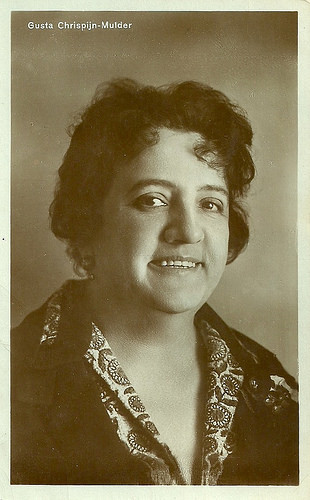
Dutch postcard by Ed. Weenenk & Snel, The Hague.
Frou-frou
Gusta Chrispijn-Mulder was born Augusta Geertruida Maria Mulder in Amsterdam in 1876. Her parents were Herman Mulder and Augusta Maria Hilverdink.
As ‘Guusje Mulder’ she debuted in 1893 at the Amsterdam Salon des Variétés under direction of M. Kreukniet and H. Poolman. She then acted with the Van Lier Brothers in plays such as Victorien Sardou’s Frou-frou.
Subsequently she was engaged for 10 years by the Nederlandsch Toneel. In 1911 she went to the Toneelvereniging and performed in the major Dutch plays Vorstenschool (Kings School) by Multatuli and Allerzielen (All Souls) by Herman Heijermans.
Chrispijn-Mulder also worked at the Rotterdams Toneel. In 1917 she moved to the Hofstad Toneel in The Hague, in 1924 at the Odeon-Theatre in the same city.

Louis Chrispijn junior . Dutch postcard by Weenenk & Snel, Den Haag. Photo: Willem Coret.
Famous for her clear declamation
In 1902 Gusta Chrispijn was married to actor-director Louis Chrispijn junior (1876-1931) and was the mother of actress Lous (Louise) Chrispijn (1898-1940). Apparently their daughter was born before they were married.
While her husband had been active as director and actor in silent cinema in the 1910s, Gusta didn’t act in silent films. When sound cinema set in in the Netherlands, though, Gusta Chrispijn-Mulder, who was famous for her clear declamation, often played supporting parts.
She was often casted as negative characters, such as the acrimonious Arabella who is taught a lesson in the Dutch comedy De familie van mijn vrouw/My Wife's Family (Jaap Speyer, 1935), starring Sylvain Poons as Arabella’s husband Josef.
Other parts followed in the comedies Het meisje met den blauwen hoed/The Girl with the Blue Hat (Rudolf Meinert 1934), starring Truus van Aalten and Roland Varno , Malle gevallen/Silly Situations (Jaap Speyer, 1934), starring Louis Borel , Roland Varno and Jopie Koopman , De vier Mullers/The four Mullers (Rudolf Meinert, 1934), starring Johan Heesters , and Amsterdam bij nacht/Amsterdam by Night (Alex Benno, 1936), starring Louis de Bree and Annie van Duyn .
In 1937-1938 she did a 10-months stage tour with the company of Cor Ruys through the former Dutch East Indies (now Indonesia).
Her last film part was as director of the orphanage in Vadertje Langbeen/Daddy Longlegs (Friedrich Zelnik, 1938), based on Jean Webster’s novella Daddy-Long-Legs and its subsequent play, and starring Lily Bouwmeester as the girl who falls in love with her benefactor (Paul Storm).
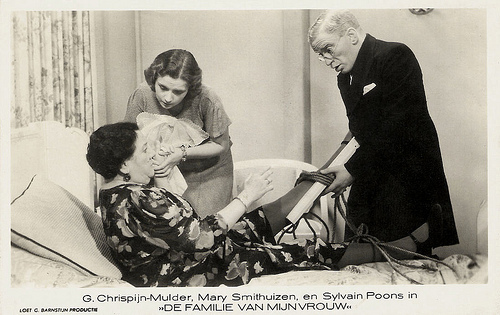
Dutch postcard by M. B.& Z. (M. Bonnist & Zonen, Amsterdam). Photo: Loet C. Barnstijn Film. Publicity still for De familie van mijn vrouw/My Wife's Family (Jaap Speyer, 1935) with Mary Smithuysen and Sylvain Poons .
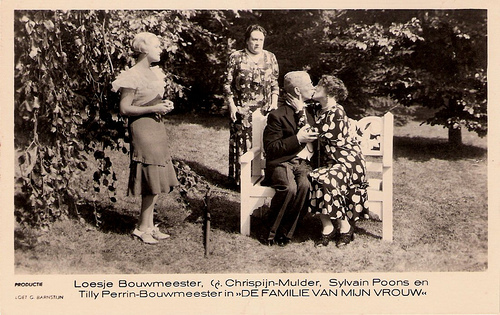
Dutch postcard by M. B.& Z. (M. Bonnist & Zonen, Amsterdam). Photo: Loet C. Barnstijn Film. Publicity still for De familie van mijn vrouw/My Wife's Family (Jaap Speyer, 1935) with Loesje Bouwmeester , Sylvain Poons and Tilly Perin-Bouwmeester.
Expelled from the stage for five years
During the Second World War Gusta Chrispijn-Mulder, who had already lost her husband in 1931 also lost her daughter, who died at the age of 42 in July 1940.
During the war Gusta didn’t act in films, though some of her 1930s films were still shown in cinemas. There had been a plan in late 1940 to act in short films by director Gerard Rutten, but this project never materialised.
In addition to some radio work and declamation lessons, she mainly acted on stage at the theatre companies De Voortrekkers, Noordhollands Toneel and De Komedianten. At the Noordhollands Toneel she was one of the best paid actresses, earning 5000 guilders per year, and in plays directed by Jan de Vos she had leads, though being in her sixties already.
Because of this she was sentenced in 1945 to be expelled from the stage for five years, but in 1947 this was withdrawn.
Gusta Chrispijn-Mulder died at age 78 in Amsterdam in 1955. She was buried on the Amsterdam cemetery Zorgvlied.
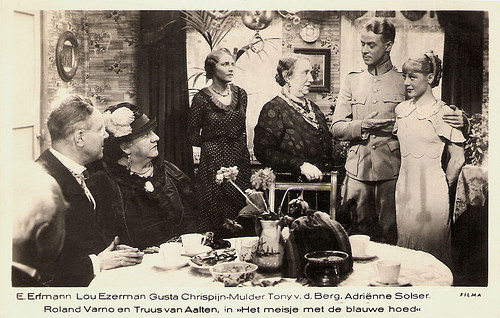
Dutch postcard by M. B. & Z. (M. Bonnist & Zonen, Amsterdam). Photo: Filma. Publicity still for Het Meisje met de Blauwe Hoed/The Girl with the Blue Hat (Rudolf Meinert, 1934) with a.o. Roland Varno and Truus van Aalten .
Clip from De familie van mijn vrouw/My Wife's Family (Jaap Speyer, 1935). Source: Eye (YouTube).
Clip from Amsterdam bij nacht/Amsterdam by Night (Alex Benno, 1936). Source: Eye (YouTube).
Sources: Eyefilm, Delpher and .

Dutch postcard by Ed. Weenenk & Snel, The Hague.
Frou-frou
Gusta Chrispijn-Mulder was born Augusta Geertruida Maria Mulder in Amsterdam in 1876. Her parents were Herman Mulder and Augusta Maria Hilverdink.
As ‘Guusje Mulder’ she debuted in 1893 at the Amsterdam Salon des Variétés under direction of M. Kreukniet and H. Poolman. She then acted with the Van Lier Brothers in plays such as Victorien Sardou’s Frou-frou.
Subsequently she was engaged for 10 years by the Nederlandsch Toneel. In 1911 she went to the Toneelvereniging and performed in the major Dutch plays Vorstenschool (Kings School) by Multatuli and Allerzielen (All Souls) by Herman Heijermans.
Chrispijn-Mulder also worked at the Rotterdams Toneel. In 1917 she moved to the Hofstad Toneel in The Hague, in 1924 at the Odeon-Theatre in the same city.

Louis Chrispijn junior . Dutch postcard by Weenenk & Snel, Den Haag. Photo: Willem Coret.
Famous for her clear declamation
In 1902 Gusta Chrispijn was married to actor-director Louis Chrispijn junior (1876-1931) and was the mother of actress Lous (Louise) Chrispijn (1898-1940). Apparently their daughter was born before they were married.
While her husband had been active as director and actor in silent cinema in the 1910s, Gusta didn’t act in silent films. When sound cinema set in in the Netherlands, though, Gusta Chrispijn-Mulder, who was famous for her clear declamation, often played supporting parts.
She was often casted as negative characters, such as the acrimonious Arabella who is taught a lesson in the Dutch comedy De familie van mijn vrouw/My Wife's Family (Jaap Speyer, 1935), starring Sylvain Poons as Arabella’s husband Josef.
Other parts followed in the comedies Het meisje met den blauwen hoed/The Girl with the Blue Hat (Rudolf Meinert 1934), starring Truus van Aalten and Roland Varno , Malle gevallen/Silly Situations (Jaap Speyer, 1934), starring Louis Borel , Roland Varno and Jopie Koopman , De vier Mullers/The four Mullers (Rudolf Meinert, 1934), starring Johan Heesters , and Amsterdam bij nacht/Amsterdam by Night (Alex Benno, 1936), starring Louis de Bree and Annie van Duyn .
In 1937-1938 she did a 10-months stage tour with the company of Cor Ruys through the former Dutch East Indies (now Indonesia).
Her last film part was as director of the orphanage in Vadertje Langbeen/Daddy Longlegs (Friedrich Zelnik, 1938), based on Jean Webster’s novella Daddy-Long-Legs and its subsequent play, and starring Lily Bouwmeester as the girl who falls in love with her benefactor (Paul Storm).

Dutch postcard by M. B.& Z. (M. Bonnist & Zonen, Amsterdam). Photo: Loet C. Barnstijn Film. Publicity still for De familie van mijn vrouw/My Wife's Family (Jaap Speyer, 1935) with Mary Smithuysen and Sylvain Poons .

Dutch postcard by M. B.& Z. (M. Bonnist & Zonen, Amsterdam). Photo: Loet C. Barnstijn Film. Publicity still for De familie van mijn vrouw/My Wife's Family (Jaap Speyer, 1935) with Loesje Bouwmeester , Sylvain Poons and Tilly Perin-Bouwmeester.
Expelled from the stage for five years
During the Second World War Gusta Chrispijn-Mulder, who had already lost her husband in 1931 also lost her daughter, who died at the age of 42 in July 1940.
During the war Gusta didn’t act in films, though some of her 1930s films were still shown in cinemas. There had been a plan in late 1940 to act in short films by director Gerard Rutten, but this project never materialised.
In addition to some radio work and declamation lessons, she mainly acted on stage at the theatre companies De Voortrekkers, Noordhollands Toneel and De Komedianten. At the Noordhollands Toneel she was one of the best paid actresses, earning 5000 guilders per year, and in plays directed by Jan de Vos she had leads, though being in her sixties already.
Because of this she was sentenced in 1945 to be expelled from the stage for five years, but in 1947 this was withdrawn.
Gusta Chrispijn-Mulder died at age 78 in Amsterdam in 1955. She was buried on the Amsterdam cemetery Zorgvlied.

Dutch postcard by M. B. & Z. (M. Bonnist & Zonen, Amsterdam). Photo: Filma. Publicity still for Het Meisje met de Blauwe Hoed/The Girl with the Blue Hat (Rudolf Meinert, 1934) with a.o. Roland Varno and Truus van Aalten .
Clip from De familie van mijn vrouw/My Wife's Family (Jaap Speyer, 1935). Source: Eye (YouTube).
Clip from Amsterdam bij nacht/Amsterdam by Night (Alex Benno, 1936). Source: Eye (YouTube).
Sources: Eyefilm, Delpher and .
Published on June 22, 2015 22:00
June 21, 2015
Elfriede Heisler
German actress Elfriede Heisler (1885-1919) was a star of the early silent film era. She appeared in 11 German and Austrian films and her career was promising, but at 33, she committed suicide.
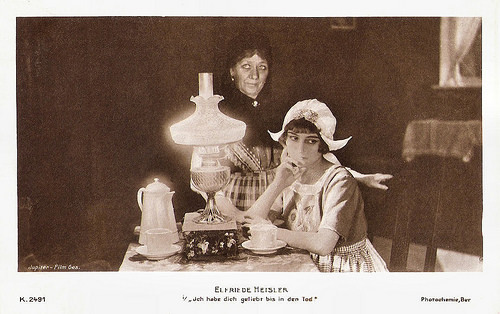
German postcard by Photochemie, Berlin, no. K.2491. Photo: Jupiter-Film Ges. Photo: publicity still for Ich habe dich geliebt bis in den Tod//I have loved you to death (1918).
The wandering Jew
Elfriede Heisler was born Elfriede Quabius in 1885 in Breslau, Germany (according to some sources, she was born in 1889).
She started her acting career in the theatre. Heisler worked in the provinces and later at the Friedrich-Wilhelmstädtischen Schauspielhaus in Berlin. In 1910 she got an engagement at the Königliche Berliner Schauspielhaus, where she played leading roles in light entertainment plays.
In 1912, she made her camera debut and played under the direction of Emil Albes in short silent films like Der Dritte/The Third (Emil Albes, 1912) with Hans Mierendorf , and Fürstenliebe/Royal Love (Emil Albes, 1912) starring Hugo Flink.
IMDb only mentions three of her later films: the patriotic drama Schwert und Herd/Sword and Hearth (Georg Victor Mendel, 1916) starring Carl de Vogt , Die lachende Maske/The Laughing Mask (Willy Zeyn, 1918) with Rosa Valetti, and the biblical epic Das Buch Esther/The Book of Esther (Uwe Jens Krafft, Ernst Reicher, 1919). Co-director Ernst Reicher played Ahasver or the wandering Jew, and Stella Harf played Queen Esther.
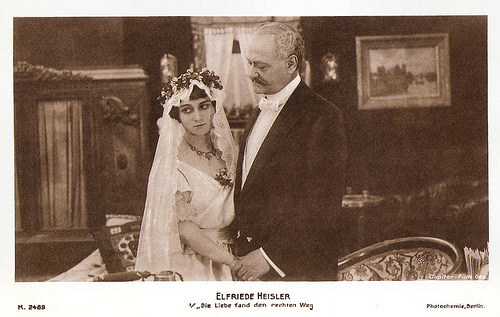
German postcard by Photochemie, Berlin, no. K.2489. Photo: Jupiter-Film Ges. Photo: publicity still for Die Liebe fand den rechten Weg/Love was on the right path (N.N., 1918).
Suicide
At Steffi-Line , Stephanie D’heil mentions also the film Seltsame Seelen/Strange Souls (Emil Albes, Margot Meyer, 1918), and Thomas Staedeli at Cyranos adds Die Tarantella/The Tarantella (N.N., 1912) with Hugo Flink and Ludwig Trautmann , and Frauchen in Nöten/Owner in trouble (William Karfiol, 1918) with Kurt Vespermann .
In Austria she played for Jupiter Film in Ich habe Dich geliebt bis in den Tod/I have loved you to death (1918), Das Glück im Rinnstein/The happiness in the gutter (1918), and Die Liebe fand den rechten Weg/Love was on the right path (1918), with Erwin Fichtner.
When her final film, Das Buch Esther/The Book of Esther, was first shown in the cinemas in 1919, the star of the film was no longer alive.
Elfriede Heisler had died in 1919 in the aftermath of a suicide attempt with Veronal (barbital). Reportedly, the motive for the suicide attempt was an unhappy love affair. She was only 33.
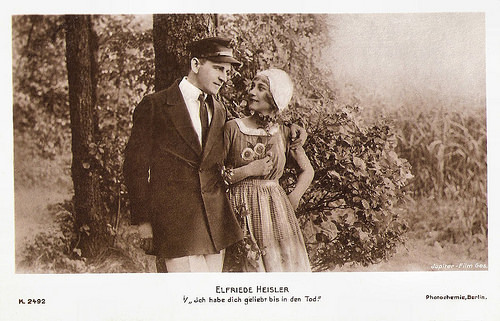
German postcard by Photochemie, Berlin, no. K.2492. Photo: Jupiter-Film Ges. Photo: publicity still for Ich habe dich geliebt bis in den Tod/I have loved you to death (N.N., 1918). Her co-star in this film was Erwin Fichtner.
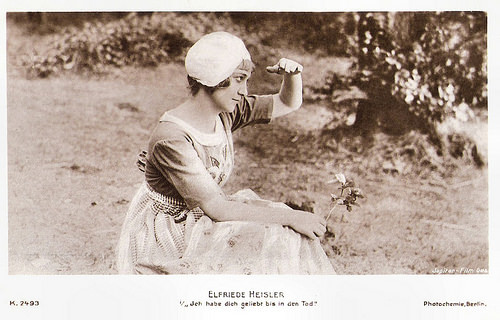
German postcard by Photochemie, Berlin, no. K.2493. Photo: Jupiter-Film Ges. Photo: publicity still for Ich habe dich geliebt bis in den Tod//I have loved you to death (N.N., 1918).
Sources: Stephanie D’heil (Steffi-Line - German), Thomas Staedeli (Cyranos), The German Early Cinema Database, Wikipedia (German) and .

German postcard by Photochemie, Berlin, no. K.2491. Photo: Jupiter-Film Ges. Photo: publicity still for Ich habe dich geliebt bis in den Tod//I have loved you to death (1918).
The wandering Jew
Elfriede Heisler was born Elfriede Quabius in 1885 in Breslau, Germany (according to some sources, she was born in 1889).
She started her acting career in the theatre. Heisler worked in the provinces and later at the Friedrich-Wilhelmstädtischen Schauspielhaus in Berlin. In 1910 she got an engagement at the Königliche Berliner Schauspielhaus, where she played leading roles in light entertainment plays.
In 1912, she made her camera debut and played under the direction of Emil Albes in short silent films like Der Dritte/The Third (Emil Albes, 1912) with Hans Mierendorf , and Fürstenliebe/Royal Love (Emil Albes, 1912) starring Hugo Flink.
IMDb only mentions three of her later films: the patriotic drama Schwert und Herd/Sword and Hearth (Georg Victor Mendel, 1916) starring Carl de Vogt , Die lachende Maske/The Laughing Mask (Willy Zeyn, 1918) with Rosa Valetti, and the biblical epic Das Buch Esther/The Book of Esther (Uwe Jens Krafft, Ernst Reicher, 1919). Co-director Ernst Reicher played Ahasver or the wandering Jew, and Stella Harf played Queen Esther.

German postcard by Photochemie, Berlin, no. K.2489. Photo: Jupiter-Film Ges. Photo: publicity still for Die Liebe fand den rechten Weg/Love was on the right path (N.N., 1918).
Suicide
At Steffi-Line , Stephanie D’heil mentions also the film Seltsame Seelen/Strange Souls (Emil Albes, Margot Meyer, 1918), and Thomas Staedeli at Cyranos adds Die Tarantella/The Tarantella (N.N., 1912) with Hugo Flink and Ludwig Trautmann , and Frauchen in Nöten/Owner in trouble (William Karfiol, 1918) with Kurt Vespermann .
In Austria she played for Jupiter Film in Ich habe Dich geliebt bis in den Tod/I have loved you to death (1918), Das Glück im Rinnstein/The happiness in the gutter (1918), and Die Liebe fand den rechten Weg/Love was on the right path (1918), with Erwin Fichtner.
When her final film, Das Buch Esther/The Book of Esther, was first shown in the cinemas in 1919, the star of the film was no longer alive.
Elfriede Heisler had died in 1919 in the aftermath of a suicide attempt with Veronal (barbital). Reportedly, the motive for the suicide attempt was an unhappy love affair. She was only 33.

German postcard by Photochemie, Berlin, no. K.2492. Photo: Jupiter-Film Ges. Photo: publicity still for Ich habe dich geliebt bis in den Tod/I have loved you to death (N.N., 1918). Her co-star in this film was Erwin Fichtner.

German postcard by Photochemie, Berlin, no. K.2493. Photo: Jupiter-Film Ges. Photo: publicity still for Ich habe dich geliebt bis in den Tod//I have loved you to death (N.N., 1918).
Sources: Stephanie D’heil (Steffi-Line - German), Thomas Staedeli (Cyranos), The German Early Cinema Database, Wikipedia (German) and .
Published on June 21, 2015 22:00
June 20, 2015
Joan Greenwood
Silky, English actress Joan Greenwood (1921-1987) made several memorable appearances in classic film comedies of the 1940s and 1950s. Her husky, sultry voice was her trademark, and in 1995 she was ranked number 63 on Empire magazine's list of the 100 Sexiest Stars in film history.
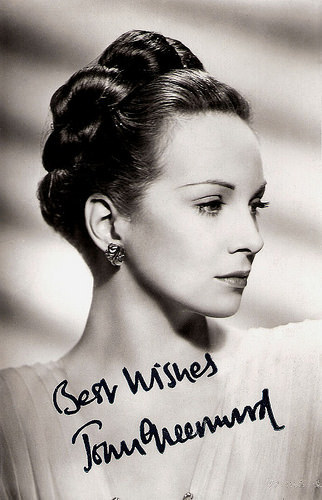
British postcard by Astra. Photo: J. Arthur Rank Organisation.
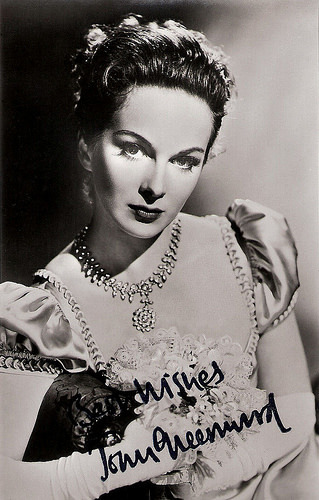
British autograph card.
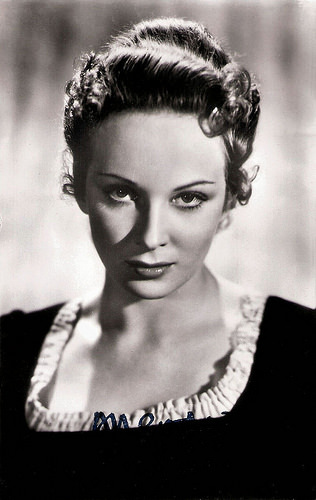
British autograph card.
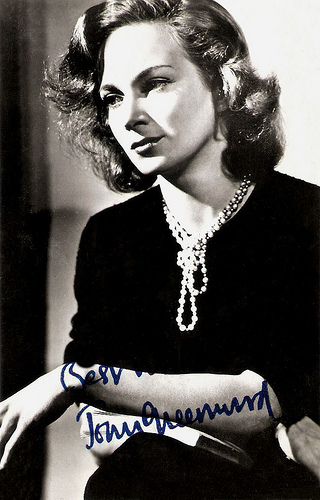
British postcard.
A Special Blend of the Aristocratic and the Sultry
Joan Greenwood was born in Chelsea in 1921 as the daughter of renowned British artist Sydney Earnshaw Greenwood.
She was trained at the Royal Academy of Dramatic Art and made her stage debut at age 18. Three years later she was cast by Leslie Howard opposite himself in the wartime morale-booster The Gentle Sex (Leslie Howard, 1942). On the stage she appeared with Donald Wolfit's theatre company in the years following World War II.
The gifted Greenwood possessed a special blend of the aristocratic and the sultry which made her extremely useful for a time in British film. Between 1948 and 1958 she made several memorable screen appearances, most notably as Sibella, the bewitching, blackmailing mistress of anti-hero Dennis Price in the black comedy Kind Hearts and Coronets (Robert Hamer, 1949), and as the Honourable Gwendolen Fairfax in the film adaptation of Oscar Wilde’s The Importance of Being Earnest (Anthony Asquith, 1952).
She also appeared in two Ealing comedies, Whisky Galore! (Alexander Mackendrick, 1949) and as the mercenary lady friend of inventor Alec Guinness in The Man in the White Suit (Alexander Mackendrick, 1952).
In 1954, she starred in her first Broadway production, The Confidential Clerk. Other films in which she appeared include Monsieur Ripois (René Clément, 1954) starring Gérard Philipe , Father Brown (Robert Hamer, 1954) opposite Alec Guinness , the Gothic Swashbuckler Moonfleet (Fritz Lang, 1955) with Stewart Granger , and Stage Struck (Sidney Lumet, 1958) starring Henry Fonda.
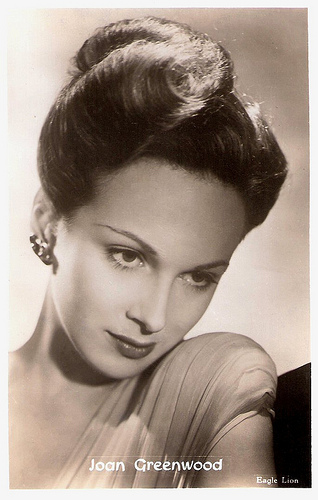
Vintage postcard. Photo: Eagle Lion.
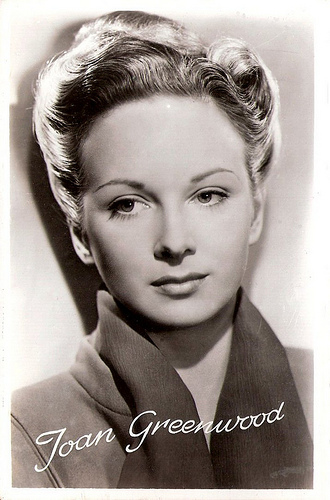
Dutch postcard by Uitg. Takken, Utrecht.

German postcard by Film-Postkartenverlag Hbg., Bergedorf, no. 159. Photo: J. Arthur Rank Organisation.
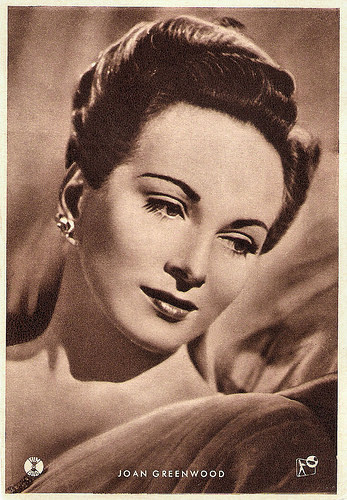
German collectors card, no. 4408. Photo: Fox Film.
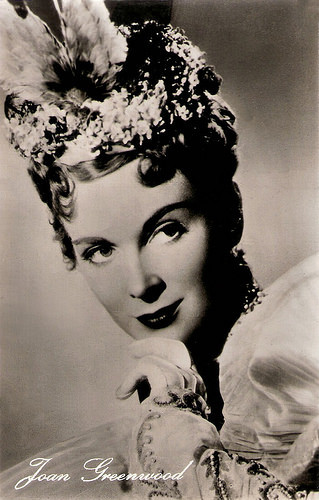
East-German postcard by VEB Progress Film-Vertrieb, Berlin, no. 1068, 1959. Photo: J. Arthur Rank. Publicity still for The Importance of Being Earnest (Anthony Asquith, 1952).
More Eccentric Than Sexy
From the 1960s on Joan Greenwood specialized in highly enjoyable character roles, still classy and authoritative but more eccentric than sexy. Her films included the Jules Verne based Mysterious Island (Cy Endfield, 1961), and Tom Jones (Tony Richardson, 1963), for which she was nominated for a Golden Globe as Best Supporting Actress.
In 1960, Greenwood appeared as the title character in a stage production of Henrik Ibsen's Hedda Gabler at The Oxford Playhouse. Starring opposite her as Brack was the actor André Morell. They fell in love and flew in secret to Jamaica, where they were married, remaining together until his death in 1978.
On TV she appeared as Lady Carlton, a quirky romance novelist and landlady to the main characters in the British sitcom Girls On Top (1985) with Dawn French and Jennifer Saunders.
In 1987 Joan Greenwood died of a heart attack in London five days prior to her 66th birthday. Her last film was the fine Charles Dickens adaptation Little Dorrit (Christine Edzard, 1988), made the year of her death. She and André Morell had one child, actor Jason Morell.
Trailer Kind Hearts and Coronets (1949). Source: Hermthy (YouTube).
Trailer The Importance of Being Earnest (1952). Source: MOVIECLIPS Classic Trailers (YouTube).
Trailer of Mysterious Island (1961). Source: Plamen Plamenov (YouTube).
Trailer of Tom Jones (1963). Source: R6dw6C (YouTube).
Sources: Hal Erickson (AllMovie), Wikipedia, TCM Movie Database, and .

British postcard by Astra. Photo: J. Arthur Rank Organisation.

British autograph card.

British autograph card.

British postcard.
A Special Blend of the Aristocratic and the Sultry
Joan Greenwood was born in Chelsea in 1921 as the daughter of renowned British artist Sydney Earnshaw Greenwood.
She was trained at the Royal Academy of Dramatic Art and made her stage debut at age 18. Three years later she was cast by Leslie Howard opposite himself in the wartime morale-booster The Gentle Sex (Leslie Howard, 1942). On the stage she appeared with Donald Wolfit's theatre company in the years following World War II.
The gifted Greenwood possessed a special blend of the aristocratic and the sultry which made her extremely useful for a time in British film. Between 1948 and 1958 she made several memorable screen appearances, most notably as Sibella, the bewitching, blackmailing mistress of anti-hero Dennis Price in the black comedy Kind Hearts and Coronets (Robert Hamer, 1949), and as the Honourable Gwendolen Fairfax in the film adaptation of Oscar Wilde’s The Importance of Being Earnest (Anthony Asquith, 1952).
She also appeared in two Ealing comedies, Whisky Galore! (Alexander Mackendrick, 1949) and as the mercenary lady friend of inventor Alec Guinness in The Man in the White Suit (Alexander Mackendrick, 1952).
In 1954, she starred in her first Broadway production, The Confidential Clerk. Other films in which she appeared include Monsieur Ripois (René Clément, 1954) starring Gérard Philipe , Father Brown (Robert Hamer, 1954) opposite Alec Guinness , the Gothic Swashbuckler Moonfleet (Fritz Lang, 1955) with Stewart Granger , and Stage Struck (Sidney Lumet, 1958) starring Henry Fonda.

Vintage postcard. Photo: Eagle Lion.

Dutch postcard by Uitg. Takken, Utrecht.

German postcard by Film-Postkartenverlag Hbg., Bergedorf, no. 159. Photo: J. Arthur Rank Organisation.

German collectors card, no. 4408. Photo: Fox Film.

East-German postcard by VEB Progress Film-Vertrieb, Berlin, no. 1068, 1959. Photo: J. Arthur Rank. Publicity still for The Importance of Being Earnest (Anthony Asquith, 1952).
More Eccentric Than Sexy
From the 1960s on Joan Greenwood specialized in highly enjoyable character roles, still classy and authoritative but more eccentric than sexy. Her films included the Jules Verne based Mysterious Island (Cy Endfield, 1961), and Tom Jones (Tony Richardson, 1963), for which she was nominated for a Golden Globe as Best Supporting Actress.
In 1960, Greenwood appeared as the title character in a stage production of Henrik Ibsen's Hedda Gabler at The Oxford Playhouse. Starring opposite her as Brack was the actor André Morell. They fell in love and flew in secret to Jamaica, where they were married, remaining together until his death in 1978.
On TV she appeared as Lady Carlton, a quirky romance novelist and landlady to the main characters in the British sitcom Girls On Top (1985) with Dawn French and Jennifer Saunders.
In 1987 Joan Greenwood died of a heart attack in London five days prior to her 66th birthday. Her last film was the fine Charles Dickens adaptation Little Dorrit (Christine Edzard, 1988), made the year of her death. She and André Morell had one child, actor Jason Morell.
Trailer Kind Hearts and Coronets (1949). Source: Hermthy (YouTube).
Trailer The Importance of Being Earnest (1952). Source: MOVIECLIPS Classic Trailers (YouTube).
Trailer of Mysterious Island (1961). Source: Plamen Plamenov (YouTube).
Trailer of Tom Jones (1963). Source: R6dw6C (YouTube).
Sources: Hal Erickson (AllMovie), Wikipedia, TCM Movie Database, and .
Published on June 20, 2015 22:00
June 19, 2015
Il ponte dei sospiri (1921)
A pre-announcement. From 3 till 10 October, the 34th edition of the silent film festival Le Giornate del Cinema Muto will take place in Pordenone, Italy. We will be there. One of the sections is about the forzuti, the strong men of the silent Italian cinema, like Luciano Albertini. Although this section will focus on the films Albertini made in Germany, today EFSP has a film special about one of Albertini's earlier Italian films, the four part serial Il ponte dei sospiri/The Bridge of Sighs (Domenico Gaido, 1921), produced by his own production company, Albertini Film.
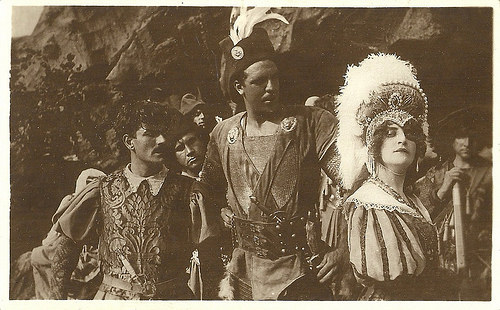
Italian postcard. Photo: Unione Cinematografica Italiana. Photo: Unione Cinematografica Italiana. Publicity still for Il ponte dei sospiri/The Bridge of Sighs (Domenico Gaido, 1921). Caption: Imperia,the most beautiful Roman courtesan, will select the bandit Scalabrino for one night of love, causing the hate and jealousy of Sandrigo.
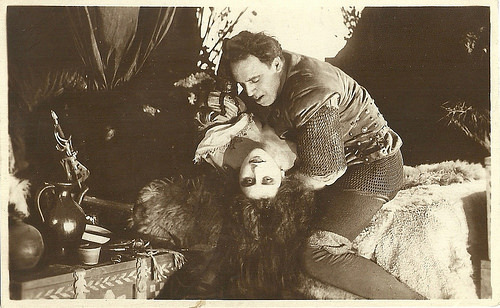
Italian postcard. Photo: Unione Cinematografica Italiana. Photo: Unione Cinematografica Italiana. Publicity still for Il ponte dei sospiri/The Bridge of Sighs (Domenico Gaido, 1921). Caption: In the cave of the bandits Imperia becomes the lover of Scalabrino.
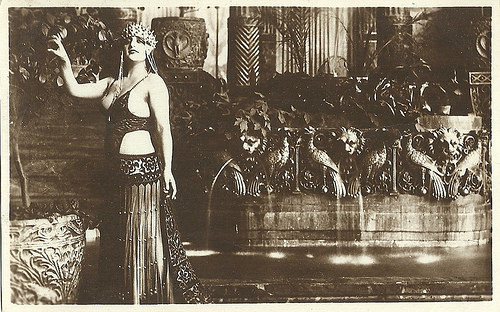
Italian postcard. Photo: Unione Cinematografica Italiana. Photo: Unione Cinematografica Italiana. Publicity still for Il ponte dei sospiri/The Bridge of Sighs (Domenico Gaido, 1921). Caption: Imperia, the empress of the courtesans, is dressed in ball attire, for her famous dances.
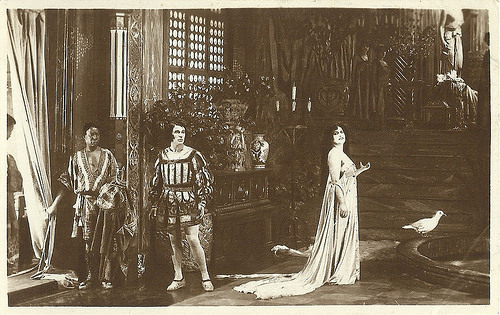
Italian postcard. Photo: Unione Cinematografica Italiana. Photo: Unione Cinematografica Italiana. Publicity still for Il ponte dei sospiri/The Bridge of Sighs (Domenico Gaido, 1921). Caption: Imperia tries to seduce Rolando, but she is rejected, and will vilely take revenge.
Falsely accused
The plot of Il ponte dei sospiri/The Bridge of Sighs (Domenico Gaido, 1921) reminds of Alexandre Dumas' novel The Count of Monte Christo.
Luciano Albertini plays Rolando Candiano, son of the Doge of Venice. Rolando is falsely accused of murder by his enemies.
One enemy, the Inquisitor Foscari (Armand Pouget) plots to become Doge himself, another (Altieri - Luigi Stinchi ) wants to steal the daughter of Dandolo (Bonaventura Ibanez), the beautiful Leonora (Carolina White), Rolando's fiancee, a third (Imperia - Antonietta Calderari) is a courtesan rejected by Rolando, and the fourth is Bembo (Agostino Borgato).
Imperia has killed a suitor, the men use her rejection by Rolando to push her to revenge herself and accuse Rolando. On the day of his marriage Rolando is arrested, trialled and passes the Bridge of Sighs before entering lifetime imprisonment.
His father is dethroned as Doge, blinded and reduced to a wandering beggar. His mother is mocked by the mob but saved by the courageous and good-hearted bandit Scalabrino (Onorato Garaveo), with whom Imperia had one night of love, resulting in her daughter Bianca.
There is also Sandrigo who hates Scalabrino who humiliated him in the past. Years after, Rolando manages to escape with the help of Scalabrino and take revenge.
The false Doge Foscari is dethroned but escapes the same fate of Doge Candiano, being blinded, as Candiano prevents the horrific act to happen twice. Foscari goes mad instead.
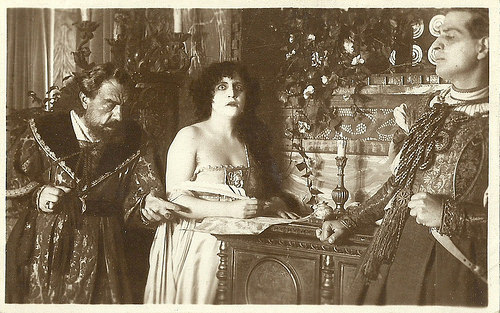
Italian postcard. Photo: Unione Cinematografica Italiana. Photo: Unione Cinematografica Italiana. Publicity still for Il ponte dei sospiri/The Bridge of Sighs (Domenico Gaido, 1921). Caption: The wrath of the torturer will fall upon the generous Rolando, who is innocently accused of having killed Giovanni Davila, who actually has been struck by Imperia's dagger (Imperia while signing the accusation).
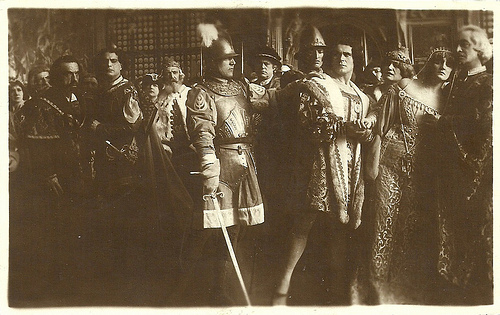
Italian postcard. Photo: Unione Cinematografica Italiana. Publicity still of Luciano Albertini as Rolando Candiano in Il ponte dei sospiri/The Bridge of Sighs (Domenico Gaido, 1921). From left to right Agostino Borgato (Bembo), Luigi Stinchi (Altieri), sig. Pieri (the Doge Candiano), an unknown actor as a soldier, Armand Pouget (the Inquisitor Foscari), Luciano Albertini (Rolando Candiano), Carolina White (Leonora) and Bonaventura Ibanez (her father Dandolo). Caption: On the auspicious eve of the wedding Rolando is arrested, and not the white bridal room and the kiss of his most beautiful bride await him but the Bridge of Sighs.
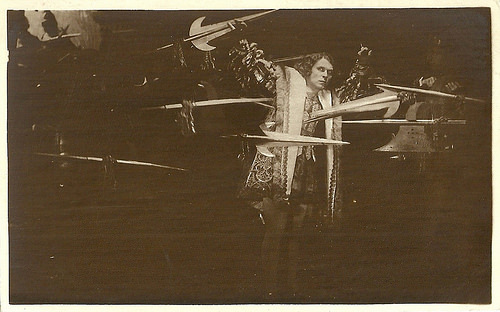
Italian postcard. Photo: Unione Cinematografica Italiana. Photo: Unione Cinematografica Italiana. Publicity still for Il ponte dei sospiri/The Bridge of Sighs (Domenico Gaido, 1921). Caption: The young and very brave son of Doge Candiano, Rolando ( Luciano Albertini ), is pushed into prison by halberds.
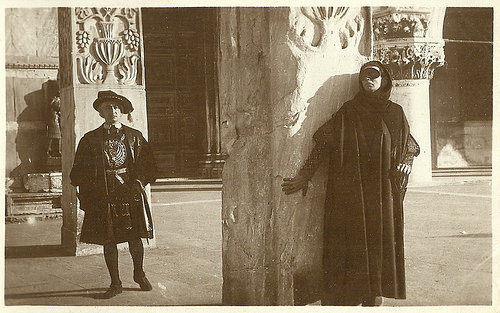
Italian postcard. Photo: Unione Cinematografica Italiana. Photo: Unione Cinematografica Italiana. Publicity still for Il ponte dei sospiri/The Bridge of Sighs (Domenico Gaido, 1921). Caption: Misfortune is lurking for Dandolo (Bonaventura Ibanez) (Altieri follows Dandolo to challenge him to death).
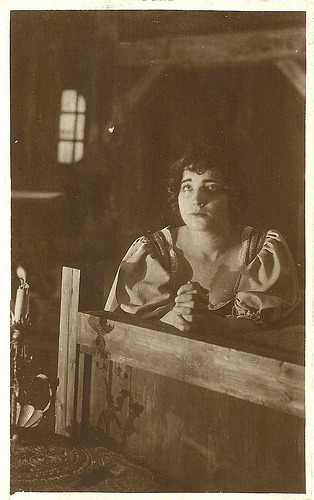
Italian postcard. Photo: Unione Cinematografica Italiana. Publicity still for Il ponte dei sospiri/The Bridge of Sighs (Domenico Gaido, 1921). Caption: Inana, prays for the soul of the unfortunate Dogaressa, Rolando's mother - saved from the mad ire of the populace by the bandit Scalabrino.
Acrobatic and daredevil acting
Muscular Italian actor Luciano Albertini (1882-1945) is best remembered for his acrobatic and daredevil acting in Italian and German silent cinema.
The serial Il ponte dei sospiri/The Bridge of Sighs (Domenico Gaido, 1921) was his last and most prestigious film in Italy, before pursing a very successful career in Germany with his own company Albertini Film, with Phoebus and finally with Aafa Film.
In 2002 the Roman Cineteca Nazionale restored the film in colour, in collaboration with Cineteca Italiana of Milan, Museo Nazionale del Cinema of Turin and Cinémathéque Suisse of Lausanne.
The restored film was presented at the 2004 Giornate del Cinema Muto. Film scholar Vittorio Martinelli considered it his best film.
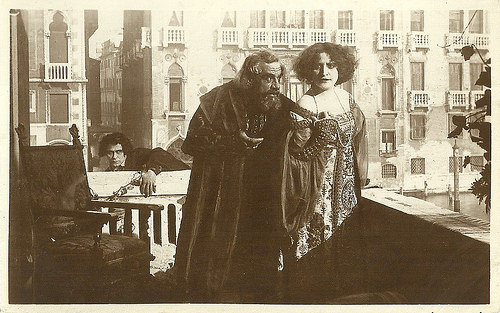
Italian postcard. Photo: Unione Cinematografica Italiana. Photo: Unione Cinematografica Italiana. Publicity still for Il ponte dei sospiri/The Bridge of Sighs (Domenico Gaido, 1921). Caption: Bembo tries to cheat Imperia and take her daughter from her, in whom he is madly in love with, but Rolando ( Luciano Albertini ) watches over her and will prevent the deceit which might strike the very sweet Bianca.
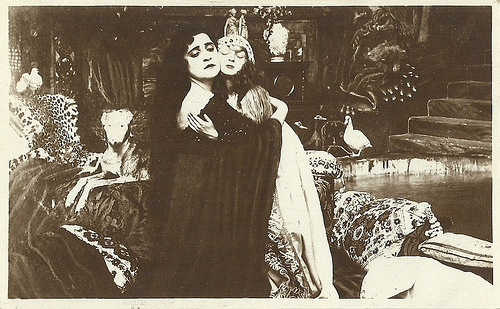
Italian postcard. Photo: Unione Cinematografica Italiana. Photo: Unione Cinematografica Italiana. Publicity still for Il ponte dei sospiri/The Bridge of Sighs (Domenico Gaido, 1921). Caption: Imperia's only true love: the little Bianca, daughter of Scalabrino.
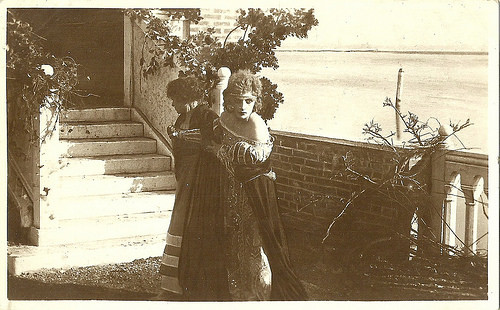
Italian postcard. Photo: Unione Cinematografica Italiana. Photo: Unione Cinematografica Italiana. Publicity still for Il ponte dei sospiri/The Bridge of Sighs (Domenico Gaido, 1921). Caption: Bianca flees from the party to escape her husband Sandrigo.
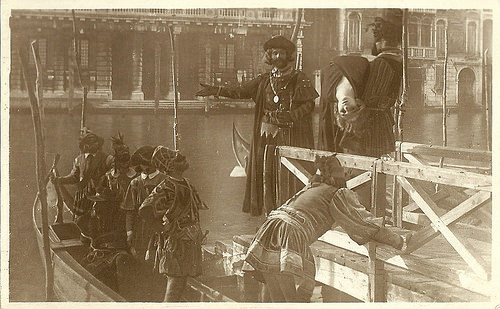
Italian postcard. Photo: Unione Cinematografica Italiana. Photo: Unione Cinematografica Italiana. Publicity still for Il ponte dei sospiri/The Bridge of Sighs (Domenico Gaido, 1921). Caption: In order to revenge himself, Rolando orders to steal her daughter Bianca.
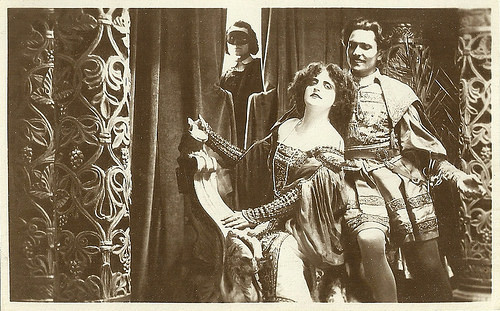
Italian postcard. Photo: Unione Cinematografica Italiana. Photo: Unione Cinematografica Italiana. Publicity still for Il ponte dei sospiri/The Bridge of Sighs (Domenico Gaido, 1921). Caption: Imperia smiles perfidiously with her mysterious, deep eyes, satisfied about her atrocious revenge, unsuspecting that her penalty is awaiting her.
Opera Singer
One of the leading ladies of Il ponte dei sospiri/The Bridge of Sighs (Domenico Gaido, 1921) is the American opera singer Carolina White.
White was born in 1885 in Grafton, Mass., and had a short-lived film career. She played opposite the famous opera singer Enrico Caruso in My Cousin (Edward José, 1918).
In 1921 she played the love interest of Luciano Albertini in Il ponte dei sospiri (Domenico Gaido, 1921) which was partly shot on location in Venice.
After that Carolina White didn't act in film anymore. She died in Rome in 1961.
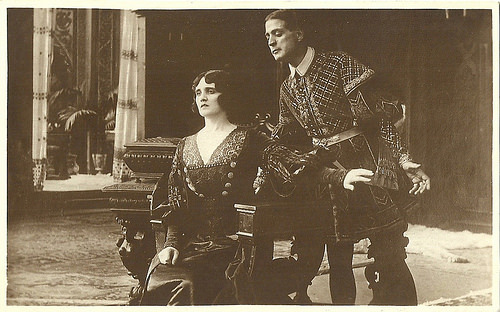
Italian postcard. Photo: Unione Cinematografica Italiana. Publicity still for Il ponte dei sospiri/The Bridge of Sighs (Domenico Gaido, 1921). Caption: Altieri longs for the moment in which he can finally kiss his wife on her lips. But Leonora heroically remains faithful to her old and unforgotten love. Only Rolando may enjoy the divine kiss from her lips.
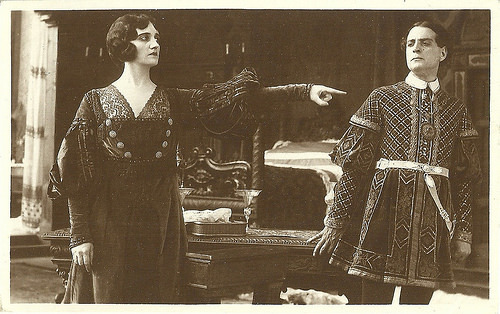
Italian postcard. Photo: Unione Cinematografica Italiana. Publicity still for Il ponte dei sospiri/The Bridge of Sighs (Domenico Gaido, 1921). Caption: Leonora chases her husband, about whom she has discovered the infamy and complicity with Imperia to Rolando's detriment.
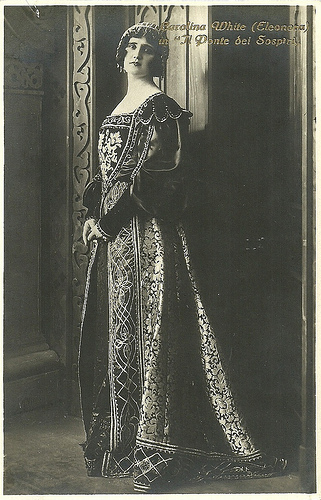
Italian postcard by Ed. G.B. Falci, Milano, no. 56. Photo: La Fotominio. Carolina White in Il ponte dei sospiri/The Bridge of Sighs (Domenico Gaido, 1921).
Sources: E Muto Fu (Italian), sempre in penombra (Italian) and IMDb.

Italian postcard. Photo: Unione Cinematografica Italiana. Photo: Unione Cinematografica Italiana. Publicity still for Il ponte dei sospiri/The Bridge of Sighs (Domenico Gaido, 1921). Caption: Imperia,the most beautiful Roman courtesan, will select the bandit Scalabrino for one night of love, causing the hate and jealousy of Sandrigo.

Italian postcard. Photo: Unione Cinematografica Italiana. Photo: Unione Cinematografica Italiana. Publicity still for Il ponte dei sospiri/The Bridge of Sighs (Domenico Gaido, 1921). Caption: In the cave of the bandits Imperia becomes the lover of Scalabrino.

Italian postcard. Photo: Unione Cinematografica Italiana. Photo: Unione Cinematografica Italiana. Publicity still for Il ponte dei sospiri/The Bridge of Sighs (Domenico Gaido, 1921). Caption: Imperia, the empress of the courtesans, is dressed in ball attire, for her famous dances.

Italian postcard. Photo: Unione Cinematografica Italiana. Photo: Unione Cinematografica Italiana. Publicity still for Il ponte dei sospiri/The Bridge of Sighs (Domenico Gaido, 1921). Caption: Imperia tries to seduce Rolando, but she is rejected, and will vilely take revenge.
Falsely accused
The plot of Il ponte dei sospiri/The Bridge of Sighs (Domenico Gaido, 1921) reminds of Alexandre Dumas' novel The Count of Monte Christo.
Luciano Albertini plays Rolando Candiano, son of the Doge of Venice. Rolando is falsely accused of murder by his enemies.
One enemy, the Inquisitor Foscari (Armand Pouget) plots to become Doge himself, another (Altieri - Luigi Stinchi ) wants to steal the daughter of Dandolo (Bonaventura Ibanez), the beautiful Leonora (Carolina White), Rolando's fiancee, a third (Imperia - Antonietta Calderari) is a courtesan rejected by Rolando, and the fourth is Bembo (Agostino Borgato).
Imperia has killed a suitor, the men use her rejection by Rolando to push her to revenge herself and accuse Rolando. On the day of his marriage Rolando is arrested, trialled and passes the Bridge of Sighs before entering lifetime imprisonment.
His father is dethroned as Doge, blinded and reduced to a wandering beggar. His mother is mocked by the mob but saved by the courageous and good-hearted bandit Scalabrino (Onorato Garaveo), with whom Imperia had one night of love, resulting in her daughter Bianca.
There is also Sandrigo who hates Scalabrino who humiliated him in the past. Years after, Rolando manages to escape with the help of Scalabrino and take revenge.
The false Doge Foscari is dethroned but escapes the same fate of Doge Candiano, being blinded, as Candiano prevents the horrific act to happen twice. Foscari goes mad instead.

Italian postcard. Photo: Unione Cinematografica Italiana. Photo: Unione Cinematografica Italiana. Publicity still for Il ponte dei sospiri/The Bridge of Sighs (Domenico Gaido, 1921). Caption: The wrath of the torturer will fall upon the generous Rolando, who is innocently accused of having killed Giovanni Davila, who actually has been struck by Imperia's dagger (Imperia while signing the accusation).

Italian postcard. Photo: Unione Cinematografica Italiana. Publicity still of Luciano Albertini as Rolando Candiano in Il ponte dei sospiri/The Bridge of Sighs (Domenico Gaido, 1921). From left to right Agostino Borgato (Bembo), Luigi Stinchi (Altieri), sig. Pieri (the Doge Candiano), an unknown actor as a soldier, Armand Pouget (the Inquisitor Foscari), Luciano Albertini (Rolando Candiano), Carolina White (Leonora) and Bonaventura Ibanez (her father Dandolo). Caption: On the auspicious eve of the wedding Rolando is arrested, and not the white bridal room and the kiss of his most beautiful bride await him but the Bridge of Sighs.

Italian postcard. Photo: Unione Cinematografica Italiana. Photo: Unione Cinematografica Italiana. Publicity still for Il ponte dei sospiri/The Bridge of Sighs (Domenico Gaido, 1921). Caption: The young and very brave son of Doge Candiano, Rolando ( Luciano Albertini ), is pushed into prison by halberds.

Italian postcard. Photo: Unione Cinematografica Italiana. Photo: Unione Cinematografica Italiana. Publicity still for Il ponte dei sospiri/The Bridge of Sighs (Domenico Gaido, 1921). Caption: Misfortune is lurking for Dandolo (Bonaventura Ibanez) (Altieri follows Dandolo to challenge him to death).

Italian postcard. Photo: Unione Cinematografica Italiana. Publicity still for Il ponte dei sospiri/The Bridge of Sighs (Domenico Gaido, 1921). Caption: Inana, prays for the soul of the unfortunate Dogaressa, Rolando's mother - saved from the mad ire of the populace by the bandit Scalabrino.
Acrobatic and daredevil acting
Muscular Italian actor Luciano Albertini (1882-1945) is best remembered for his acrobatic and daredevil acting in Italian and German silent cinema.
The serial Il ponte dei sospiri/The Bridge of Sighs (Domenico Gaido, 1921) was his last and most prestigious film in Italy, before pursing a very successful career in Germany with his own company Albertini Film, with Phoebus and finally with Aafa Film.
In 2002 the Roman Cineteca Nazionale restored the film in colour, in collaboration with Cineteca Italiana of Milan, Museo Nazionale del Cinema of Turin and Cinémathéque Suisse of Lausanne.
The restored film was presented at the 2004 Giornate del Cinema Muto. Film scholar Vittorio Martinelli considered it his best film.

Italian postcard. Photo: Unione Cinematografica Italiana. Photo: Unione Cinematografica Italiana. Publicity still for Il ponte dei sospiri/The Bridge of Sighs (Domenico Gaido, 1921). Caption: Bembo tries to cheat Imperia and take her daughter from her, in whom he is madly in love with, but Rolando ( Luciano Albertini ) watches over her and will prevent the deceit which might strike the very sweet Bianca.

Italian postcard. Photo: Unione Cinematografica Italiana. Photo: Unione Cinematografica Italiana. Publicity still for Il ponte dei sospiri/The Bridge of Sighs (Domenico Gaido, 1921). Caption: Imperia's only true love: the little Bianca, daughter of Scalabrino.

Italian postcard. Photo: Unione Cinematografica Italiana. Photo: Unione Cinematografica Italiana. Publicity still for Il ponte dei sospiri/The Bridge of Sighs (Domenico Gaido, 1921). Caption: Bianca flees from the party to escape her husband Sandrigo.

Italian postcard. Photo: Unione Cinematografica Italiana. Photo: Unione Cinematografica Italiana. Publicity still for Il ponte dei sospiri/The Bridge of Sighs (Domenico Gaido, 1921). Caption: In order to revenge himself, Rolando orders to steal her daughter Bianca.

Italian postcard. Photo: Unione Cinematografica Italiana. Photo: Unione Cinematografica Italiana. Publicity still for Il ponte dei sospiri/The Bridge of Sighs (Domenico Gaido, 1921). Caption: Imperia smiles perfidiously with her mysterious, deep eyes, satisfied about her atrocious revenge, unsuspecting that her penalty is awaiting her.
Opera Singer
One of the leading ladies of Il ponte dei sospiri/The Bridge of Sighs (Domenico Gaido, 1921) is the American opera singer Carolina White.
White was born in 1885 in Grafton, Mass., and had a short-lived film career. She played opposite the famous opera singer Enrico Caruso in My Cousin (Edward José, 1918).
In 1921 she played the love interest of Luciano Albertini in Il ponte dei sospiri (Domenico Gaido, 1921) which was partly shot on location in Venice.
After that Carolina White didn't act in film anymore. She died in Rome in 1961.

Italian postcard. Photo: Unione Cinematografica Italiana. Publicity still for Il ponte dei sospiri/The Bridge of Sighs (Domenico Gaido, 1921). Caption: Altieri longs for the moment in which he can finally kiss his wife on her lips. But Leonora heroically remains faithful to her old and unforgotten love. Only Rolando may enjoy the divine kiss from her lips.

Italian postcard. Photo: Unione Cinematografica Italiana. Publicity still for Il ponte dei sospiri/The Bridge of Sighs (Domenico Gaido, 1921). Caption: Leonora chases her husband, about whom she has discovered the infamy and complicity with Imperia to Rolando's detriment.

Italian postcard by Ed. G.B. Falci, Milano, no. 56. Photo: La Fotominio. Carolina White in Il ponte dei sospiri/The Bridge of Sighs (Domenico Gaido, 1921).
Sources: E Muto Fu (Italian), sempre in penombra (Italian) and IMDb.
Published on June 19, 2015 22:00
Paul van Yperen's Blog
- Paul van Yperen's profile
- 13 followers
Paul van Yperen isn't a Goodreads Author
(yet),
but they
do have a blog,
so here are some recent posts imported from
their feed.



